Protohistory of beer in the Indus and Ganges valleys, and the Deccan Plateau.
The Indian subcontinent is one of the world's oldest and perhaps most misunderstood brewing regions. The presence and customary brewing of beer (surā) is definitely attested since 1500 BC according to Vedic literature. Archaeology and archaeobotany allow us to go back in time beyond these first testimonies to explore this territory and the protohistory of its fermented beverages. Considering the extraordinary wealth and diversity of domesticated starch plants in India, beer was soon separated from the other fermented beverages and became a beverage produced with a wide range of sophisticated brewing techniques.
We speak here of a "brewing basin" because we want to study the emergence of beer among all the fermented beverages, and then the protohistoric refinements of this starch-based beverage from the point of view of the various brewing methods. In this evolutionary perspective, we follow a chronological thread that begins with the primitive fermented beverages when they are not yet divided into distinct families (beer, wine, mead, alcoholic fermented milk). We call them "undifferentiated fermented beverages" because they stem from the processing of anything that can ferment: fruit juice, sap, starch, honey, milk, etc. Their subsequent differenciation into 4 groups reflects a general socio-economic evolution of Neolithic communities towards increasingly stratified and complex societies.
We follow the tripartite chronology applied to other brewing regions in the world, namely:
- Primitive stage: the bedrock of primitive undifferentiated fermented drinks in India. Hunter-gatherers and proto-farmers make their beverages with whatever can be fermented: berries, fruits, sap, seeds, honey, etc.
- Neolithic and proto-urbanism: fermented beverages become differentiated. Beer, wine, mead and fermented milk gradually formed four different families of fermented beverages[1].
- Protohistoric period: brewing methods become specialised within the family of beers, which includes many varieties (rice beer, barley beer, wheat beer, millets beer, eleusine beer, etc.). They are mainly based on amylolytic fermentation and malting (germination of grains) technology. In the historical period, the fermenting technique became more advanced and took precedence over the malting technique.
The Indian brewing basin refers to the whole of the subcontinent (Pakistan, India, Nepal, Bhutan, Bangladesh, Ceylon), a relatively homogeneous geographical entity from the point of view of domesticated starch plants and a region of the world sharing a historical heritage that goes back to the ancient cities of the Indus. During its protohistory, this brewing basin thus delineated is connected with corridors of diffusion (populations, plants, techniques) via Baluchistan, the north of present-day Pakistan (Oxus culture), Myanmar or the Indian Ocean (Austronesians).
The archaeological and textual data available for ancient India are concentrated in two regions: the Indus Valley and its tributaries, and the Gangetic Plain. The Deccan Plateau and the Eastern and Western Ghats, i.e. most of central and southern India, have so far yielded only indirect data on the proto-history of fermented beverages, mainly from archaeobotanical research. The ancient Vedic literature is unfortunately silent on the existence and customs of the indigenous communities that formed the vast majority of the populations of the subcontinent before the arrival of Indo-European speakers around the 2nd millennium BC (Overall map of the sub-continent around 3000 BC).
To our knowledge, Indian archaeology has not yet adopted the methods of residue analysis that can be collected from ancient ceramics[2]. These shortcomings are partly mitigated by the observation of traditional brewing methods in today North-East India, techniques which have elsewhere almost disappeared, submerged by successive waves of Western industrial beers since the 19th century[3]. Nevertheless, the description of these traditional Indian brewing methods and the ways of life that have ensured their sustainability to this day do not allow us to trace back their history over several millennia, let alone the protohistory of fermented beverages for the entire Indian subcontinent.
The role played by beer in the history of ancient India has only recently been reassessed by the study of textual sources[4]. Surā beer is mentioned in the RgVeda and other later Brahmin texts. Like the famous soma, surā beer is used in rituals. But it is also known to have been consumed regularly by elites during the 1st millennium BCE, by craftspeople, merchants and farmers. Surā beer was also and above all an usual, everyday beverage.
| The protohistory of fermented beverages in India | |||
| Phases | Evolutions | Dates BC | Archeology or written sources |
| Mixed fermented beverage basis. | Early stage. Neolithic. Domestication of food plants, pottery, proto-urbanism. | 8000-2600 | Mehrgarh I à VI (Balûchistân). Flooded plain of the Ganges. Ash Mounds Tradition, Central India (2800-1200). |
| Beer, wine and mead raise as different beverages | Social stratification, first cities, domestication of new starch plants. | 2500-1500 | Indus Civilisation (2600-1500) |
| Specialisation within the beer family | Brewing technologies became more specialised: malting, beer ferments, amylolytic plants (?). | 1500-500 | Vedic Culture in N-W India. 1500-500 BC. The 16 Mahajanapadas (6th century BC) |
This survey of the protohistory of brewing methods focuses on the technical developments. Social and cultural changes are hardly mentioned due to the lack of reliable data on the use of fermented beverages.
The six main features of the Indian brewing basin.
- The diversity of starch sources used for brewing: cereals (rice, barley, wheat, millets, eleusine, sorghum), pulses (beans, peas) and tubers. Archaeobotany sheds light on the domestication of indigenous cereals, especially varieties of rice, millet, legumes and tubers, but also on the adaptation of wheat and barley from the Fertile Crescent, and later millets and Oriza sativa var. japonica rice from China. The ancient Brahmanic literature allows us to verify that all these plant resources did indeed enter into specifically Indian brewing processes during the first millennium BC. What happened before has to be reconstituted through archaeological data.
- The multiplicity of brewing methods used: grain malting techniques coexisted with those of amylolytic ferments before the latter became the majority at the dawn of our era. Vedic literature testifies to an expertise in the making and diversity of beer ferments. These data are based on texts written about 3000 years ago. Again, what happened before remains a matter of speculation.
- The migration of pastoralists from Central Asia to northwestern India in the second millennium BC seems to have enriched the techniques for preparing indigenous fermented beverages. The introduction of curdled milk in the preparation of amylolytic ferments bears witness to this. This technique may also have an Indian origin. The Ash-Mounds of Karnataka and Andhra Pradesh testify to an Indian tradition of pastoralists breeding large livestock between 2800 and 1200 BC.
- The survival of traditional brewing methods in the north-east of the Indian sub-continent (present-day Assam, Arunachal Pradesh, Nagaland, Bhutan, Nepal, etc.). It can be explained by the geopolitics of refuge areas for ethnic groups that became a minority at the dawn of our era and a very divisive Hindu sociology. This historical phenomenon is attested in northern India and the Himalayan belt, from Kashmir to the eastern plateau of Tibet. Little is known about the broad movements of people in central and southern India[5].
- The Indian subcontinent is home to a wide variety of fermented beverages, the origin and protohistory of which are linked to its physical geography: a crossroads between the Asian subcontinents to the west, north and east, and East Africa. The coastal areas have been and remain the domain of palm and date wines. The forest-covered central India is the domain of mead and fruit wines in the cultivated areas. Northern India is the domain of rice and millet beers, formerly barley and wheat beers. The Ganges Valley is also the domain of sugarcane and cane wine. All these traditional fermented beverages have one feature in common: a strong flavouring with flowers, spices, vegetable juices and other aromatic plants.
- This great diversity and abundance of fermented beverages seems to have given rise to a distillation technology around the beginning of our era in the North West[6]. Distillation is a technical means of preserving alcohol in a context of exchange and widespread trade in fermented beverages, which are considered delicate to preserve. Distillation was preceded by a very long and necessary period of specialisation in fermented beverages, technical improvements[7], and a complex socio-economic evolution from domestic brewing and bartering to large-scale brewing in an economy that had become commercial when a part of society valued the consumption of alcohol.
1. Early fermented beverages in India (8000-2600).
Undifferentiated fermented beverages refer to beverages made from a mixture of fermentable raw materials: natural fruit sugars, beans, honey, grains, tubers, etc. These fermented beverages are a specialisation of the primitive fermented porridges insofar as they are prepared and consumed as a beverage and not as a more or less liquid food. They are the foundation or origin of fermented beverages which then specialise during protohistory to form distinct groups of fermented beverages: wines, beers, meads, fermented milks.
These undifferentiated fermented beverages are revealed through the analysis of fossilised food remains in containers discovered during archaeological excavations. These analyses identify traces of biochemical compounds resulting from the alcoholic fermentation of sweet vegetable juices, honey, saccharified starch and lactose.
The oldest food fossils show a mixed composition of beverages. They were made from concoctions of fruits, berries, honey, grains and tubers, all fermented in the same containers. These mixtures correspond to a primitive stage during which human groups collected their food and prepared their beverages with all the resources of their environment, with no other selection criteria than the seasonal availability of plants and the avoidance of poisoning. The social context (funerary rite, domestic or collective consumption) and the vessels show that we are dealing with beverages, although the difference between fermented beverage and porridge is not always obvious during the Neolithic. These mixed fermented beverages are attested in China (Jiahu, Mijiaya, Dingcun, Qiaotu), South-West Asia (Mesopotamia), Western Europe, Grece, South America (Peru).
We do not have such data for the Indian subcontinent, due to the lack of analysis of food fossils. Mesolithic rock paintings show scenes of hunting, gathering, and social life (dancing, fighting, rituals?). Central India is particularly well endowed with caves and rock shelters displaying painted scenes. Their dating is not always very accurate (8000-5000 BC?), their interpretation even less so. In the Bhimbetka caves, some scenes show the collection of wild honey. Another shows a drinking figure. (Mathpal 1984, fig. 45 et 64).
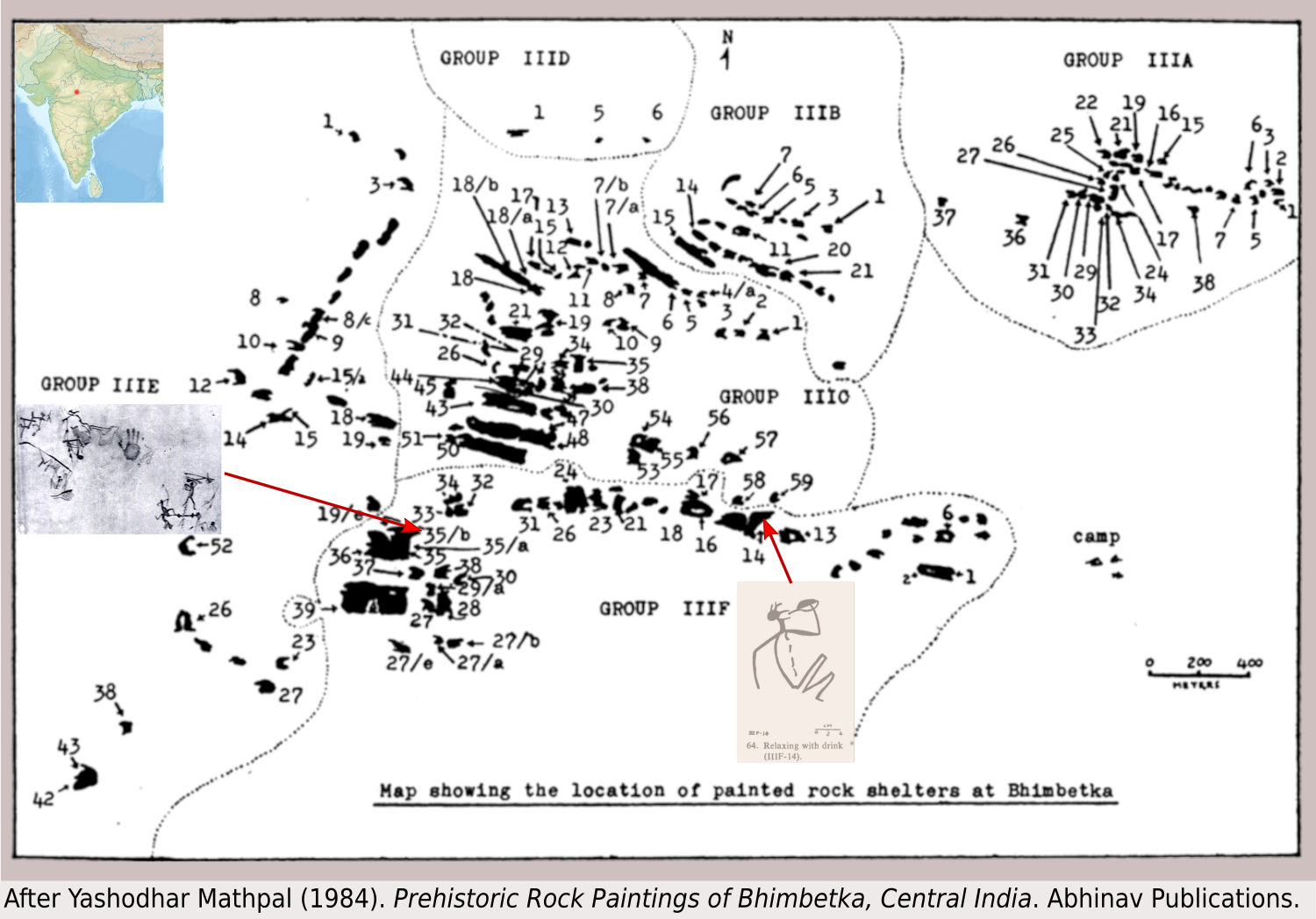 |
 |
 |
| Bhimbekta painted rock shelters map (Madhya Pradesh, India) by Yashodhar Mathpal, 1984. | Honey collection and others activities (IIIF-35-b) | Relaxing with drink (IIIF-14) |
Without any scientific analysis of Mesolithic fermented beverage fossils in India, we cannot say more. We must look to the more recent episodes of domestication of starchy plants and plants with sap or sweet juices to draw a more accurate picture of the protohistory of fermented beverages in India.
The Mesolithic-Neolithic transition in India is the subject of recent research. It is still poorly documented, except for the Indus Valley and the pre-Harappean culture (Fuller 2003, 191). Several centres of plant domestication/culture have been identified by archaeologists: the Indus Valley, which is the oldest, the north of present-day Pakistan, the middle Ganges Valley, the south of the Indian Peninsula (southern Deccan Plateau), and finally the north-east of India (Assam, Uttar Pradesh, Orissa) (Map).
Neolithisation in the Indus Valley results, among other causes, from a diffusion of barley and wheat from the Fertile Crescent around 7500 BC and reaching the Indus Valley around 4500 BC, after stages of adaptation to the semi-arid environments of southern Iran (Mehrgarh, Iran, around 5500 BC) (Stevens & al. 2016). This evolution in the Indus Valley is coupled with local domestications (cotton, zebu). In the second millennium BC, the cultivation of grapevine (Vitis vinifera), cotton (Gossypium arboreum), date palm (Phoenix dactylifera) and jujube (Ziziphus mauritiana) is attested in the Indus Valley (Fuller and Madella, 2001).
_and_barley_(Hordeum vulgare)_throughout_Eurasia_(Stevens & al. 2016).jpg) |
| Diffusion of wheat (Triticum sp.) and barley (Hordeum vulgare) throughout Eurasia between 8500-500 BC (Stevens & al. 2016, fig. 2). |
In northern Pakistan (Punjab), a "second neolithisation" after that of the pre-Harappean cultures, results from the diffusion of millets domesticated in northern China (Setaria italica L. and Panicum miliaceum L., with Canabis sativa) from Central Asia between 2000 and 1500 BC (Stevens & al. 2016).
The middle Ganges valley witnessed the domestication of Indian rice (Oriza sativa, subsp. indica), yellow foxtail (Setaria pumila), amaranth (Macrotyloma uniflorum, kulthi bean or horsegram), and various cucurbits between 6000 and 3000 BC.
The southern Indian peninsula began domesticating native millets (Brachiaria ramosa and Setaria verticillata) and pulses (Vigna mungo, Vigna radiata, Macrotyloma uniflorum again) around 3000 BC (Fuller et al. 2004, Boivin et al. 2008). These indigenous plants will remain the core food of the Indian peninsula for several millennia. Northeast India was the site of domestication of an oriental variety of rice from China (Oriza sativa, subsp. japonica), pigeon pea (Cajanus cajan, arhar dhal or tur) and corm or bulbo-tuber plants (taro Colocasia esculenta, yams Dioscorea spp.) around 2000 BC (Fuller 2003).
Between 5500 BC and 2000 BC, the domestication of starchy plants in India involved several centres and relatively complex exchanges/borrowings/adaptations (see map below) underpinned by population migrations. Archaeobotanists and linguists have tried to superimpose their respective protohistories to understand the setting up of very distinctive regional cultures (Fuller 2003).
Around 2000 BC, the whole of the Indian subcontinent has a great diversity of plant resources. In addition to cereals, legumes and tubers, there are also plants rich in sugar (palms, vines, etc.). Sugar cane (Saccharum barberi) is introduced on the Orissa and Ganges-Brahmaputra delta coast around 1000 BC by Austronesian traders. The great wealth of Indian fermented beverages has its material roots here.
These highly diversified food resources are the material substratum of important social developments in the Indian subcontinent around the 3rd millennium. The role and the processing of fermented beverages are to a large extent conditioned by these social developments.
2. Fermented beverages become specialised in India: beer, wine, mead (2600-1500 BC).
The specialisation of fermented beverages depends on the socio-economy of each brewing basin. It is consecutive to the processes of neolithisation: the beginning of agriculture or horticulture, livestock breeding, more or less complete sedentarisation, food techniques, pottery, etc. It also implies the emergence of communities or stratified societies within which each social class adopts a type of fermented beverage, a marker of social status, political power and group membership. For beer to become an autonomous fermented beverage, a community must have regular sources of starch all year round in sufficient quantity (example of Tepe Yahya). The same logic governs the advent of wines (palm wine, grape wine, cane wine, etc.) as an autonomous family of fermented beverages. Mead became an autonomous and well identified beverage when beekeeping and its corollary, a regular supply of honey, came into being.
These developments first occurred in the Indus Valley around the 3rd millennium. They are the result of local social transformations and influences from Iran via Baluchistan (Mehrgarh) and Central Asia. These developments also occurred in central India (Deccan Plateau) following an indigenous logic.
It is likely that each of the five proto-agricultural centres identified in India (cf. above) experienced a more or less specific evolution of fermented beverages. However, the still scarce data do not allow to draw an overall picture.
a) Social developments in the Indus Valley around 3500 BC.
We need a roundabout way to the south of Iran to collect some data on the evolution of fermented beverages in this region during a period just prior to the emergence of the Indus civilisation. The site of Mehrgarh is the closest. The site of Shar-i-Shokta has yielded an analysis of fermented beverage. Further west, the site of Tepe Yahya has provided clay tablets recording beer rations.
The site of Mehrgarh, located about 100 km from the western bank of the Indus (Baluchistan, Pakistan), indicates that six-row barley, einkorn, emmer wheat, jujubesand dates were cultivated there between 7000 and 5500, during a period without ceramics (Mehrgarh I). Sheep, goats and cattle are raised here. Mehrgarh is the oldest agricultural centre in South Asia. The spread of barley and wheat from the Fertile Crescent and the East ⇔ West trade networks through present-day Iran, Afghanistan and Pakistan played an important role. Mehrgarh III (4800 BCE-3500 BCE) is a Neolithic period using pottery and later copper.
Unfortunately, we do not have any analysis of fermented beverages for the Neolithic period of Mehrgarh II and III. But an analysis of fermented beverage fossils was carried out by the Italian team that excavated a nearby site in Iran, that of Shar-i-Shokta. It was occupied between 3200-2350 BCE.
| Chronology for Shar-i-Shokta (Piperno, Tosi 1975, 187. Salvatori, Tosi 2005, revised) | ||
| Periods | Dates | Settlement sizes |
| I | 3100–2750 BCE | 10.5–15.5 ha |
| II | 2750–2500 | 80 ha |
| III | 2500–2200 | 80 ha |
| IV | 2200–1700 | |
Polyphenols analysed in the remains of pots from a tomb in Shar-i-Shokta indicate the presence of alcoholic fermentation. It is associated with the remains of grains and grapes, thus with beer and wine, i.e. a mixture of fermented beverages. Their production is already separate, as at the contemporaneous site of Tepe Yahya (several distinct beverages contained in the same container), or their preparation is still the result of a combination of starchy materials and mixed fruits. The chemical analysis of the residues alone cannot settle the matter (Beer/Wine at Shahr-i-Sōkhta, Iran).
A few hundred kilometres westwards, the site of Tepe Yahya provides an insight into what may have happened at Mehrgarh. A small batch of clay tablets was discovered there, 20 of them bearing proto-Elamic writing signs, the others left blank. They date from the end of the 4th millennium. These partially deciphered tablets are records of rations of grain and beer for the maintenance of workers. Their social status is not defined (slaves, subjugated population, free cultivators, etc.).
These accounting documents have been compared by Damerow and Englund with archaic Mesopotamian records from the same period, discovered at Uruk, a bulk of several hundred tablets (Damerow, Englund 1989). They concluded that the highly stratified society of Tepe Yahya was based on the (voluntary?) tasks performed by cultivators and craftsmen whose work was compensated by rations in kind (grain, beer, wool, animals). This social system presupposes an organisation of (forced?) labour, a system of constraint and an authority controlling its functioning and the trade routes linking Mesopotamia to the Indus and the Persian Gulf to Baluchistan. The pots for distributing beer or grain had standardised capacities. So were the dimensions of the bricks for raising the walls. Seals and seal prints imply that their owners had the power to control. Luxury objects made of chlorite, copper or lapis lazuli show a strong social hierarchy. They were traded throughout southern Iran, in Mesopotamia and as far as the banks of the Indus (Mohenjo-Daro). The societies of Tepe Yahya and surrounding sites owe their existence to the rich local deposits of chlorite.
In short, the society of Tepe Yahya is the opposite of an egalitarian farming community. It is precisely in this context that beer is used as a medium to calculate the 'value' of labour. Rations of beer and grain are calculated to maintain the labour force. This requires: 1) a large grain production 2) granaries to secure access to grain stocks 3) a more or less centralised beer production 4) a standardised brewing technique so that the volume equivalent of grains⇔beer is respected each time beer rations are distributed in bowls of defined capacity.
Beer is used as a ration according to the tablets of Tepe Yahya. Is this the only fermented beverage? The proliferation of date palms decorating drinking vessels and chlorite cups suggests that palm wine played an important role in the consumption of the elites of Tepe Yahya and neighbouring sites.These fermented beverages were already technically specialised according to social stratification and differentiated consumption: for example, grape or date wine for the ruling families versus barley or wheat beer for those who produced and sustained a minority.
Unfortunately, the contents of the two typical vessels excavated at Tepe Yahya (the beer bowl and the chlorite vase-cup) have not been analysed. It is not known whether the very specific social use of these two containers also refers to two exclusive types of fermented beverages: beer and/or wine. The Mesopotamian parallel of the Archaic Dynastic is a tempting way to answer this question. Mesopotamian lexicography from the end of the 4th millennium makes a clear distinction between beer and wine, and even several qualities (densities) of beer, according to the tablets unearthed at Uruk. Is this the case at Tepe Yahya, 800 km to the east of Uruk?[8]
Did the social control technology of Tepe Yahya (grain and beer ration system, late 4th millennium) and the barley and wheat agriculture of Mehrgarh III (4800-3500 BC) inspire or influence the pre-Harappean Indus cultures of the 3rd millennium?
A wide network of exchanges covers the whole region, from the Fars in the west to the banks of the Indus in the east. In Period I, Shahr-e Sukhteh is already closely linked with sites in southern Turkmenistan, the Kandahar region of Afghanistan, the Quetta Valley and the Bampur Valley in Iran. There are also links with the Proto-Elamite cities of Ḵuzestān and Fārs.
The whole region up to Iranian Balochistan consumes fermented beverages. These are still mixed fermented beverages, half wine and half beer as in Shahr-i-Sōkhta. This movement from the west and north of Iran reached the banks of the Indus in the third millennium. The material culture gives increasing importance to cereals. Social hierarchy is evident.
The Indus Valley is home to the brilliant Indus Civilisation of the 3rd and 2nd millennia BC. It is a rich irrigated cereal plain. Its Indus agricultural economy is based on plants from the Fertile Crescent (wheat, barley, lentils, peas, flax), but also on Asian crops (sesame, millet, rice, mung bean, turd bean, melon, cucumber, cotton) and other plants like sorghum and rice. No fermented beverages have been analysed at the time of excavation[9]. The pictograms remain undeciphered insofar as they constitute a real writing system. Only the granaries, warehouses, the size of the buildings and what are interpreted as citadels suggest a highly hierarchical agricultural society, a high population density and a very advanced urbanism. The hypothesis of grain-based beer production is likely. Some filter pots found at the Harappa site and analysed by Kenoyer (Beer and Cities of the Indus) suggest equipment for preparing fermented beverages.
A puzzling intellectual adventure has led some archaeologists to imagine the invention of alcohol distillation on the banks of the Indus 4000 years ago, even before proving the existence of fermented beverages in the region at that time. To distil alcohol, one must first know how to produce it, to make beer, wine or mead! In 1972, H. Mahdihassan imagines the first distillation unit invented in the Indus cities around 2000 BC, using similar and questionable reconstructions by Marshall for the Taxila site (2nd century BC). Not having studied the brewing techniques of Indian beers, Mahdihassan interprets the term parishrut = distillate. Parishrut actually refers to the filtrate of beer brewed in the semi-solid phase with beer ferments (Vedic and Brahmanic India: Sura and brewing diagrams). Absolutely not one scintilla of evidence for a distillation![10]
Seven balls of organic material were discovered in a domestic context at a rural Harappan site in western Rajasthan, a village of craftspeople near the ancient Sarasvati River that ran parallel to the Indus. They were dated (2700/2600 BC) and analysed. They consisted mainly of starch from cereals and pulses: mung (Vigna radiata), lentil (Lens culinaris), chickpea (Cicer arietinum), millet (Pennisetum glaucum), barley (Hordeum vulgare), wheat (Triticum aestivum) and sorghum (Sorghum bicolor) (Agnihotri et al. 2021). Phytoliths identified the presence of starchy roots. This confirms the predominantly plant-based diet of the rural population at this time, and the wide diversity of starch sources. It is based on an advanced agriculture with winter crops (wheat, barley, lentil, chickpea) and summer crops (mung, sorghum, candle millet). It is known that the 3rd millennium BC saw a change in the Indian monsoon regime with a relatively warmer climate. Chromatography (GC-MS) detected the presence of calcium oxalate of plant origin (not soil contamination), a possible indication of alcoholic fermentation within these pellets composed mainly of starch. Microbiological analysis was not carried out further to detect possible microorganisms responsible for saccharification and alcohol production.
The Indus civilisation covers a vast territory and a wide variety of ecosystems. Everything suggests that it was a major brewing centre at the crossroads of two technical brewing traditions, one coming from the West and favouring the malting of cereal grains (barley, wheat, sorghum, millet), the other coming from Asia and mastering the technique of amylolytic ferments to brew husked rice or other starchy plants.
Around 1900BC, the Indus civilisation declines. The following cultures succeed each other in the North and the upper Ganges valley (Punjab) on the one hand, and in the South-East (Rangpur culture in Gujarat) on the other. The integrated Harappan culture gave way to local cultures, modestly sized settlements, the occupation of new ecosystems and the cohabitation with new populations, some indigenous, others resulting from the gradual migration of semi-nomadic pastoralists from Central Asia. The thousands of shards and pottery left by these cultures between 1900 and 1300 BC have not been subject to archaeobiochemical analysis. Little is known about their contents and functions.
Several centuries later, texts from the classical Vedic period (1300-300 BCE) speak of the surā-beer and the kinva beer-ferment (infra).
b) Social evolutions and beer in central India between 2500 and 1500 BC.
Dorian Fuller (2005) observed the selective adoption of new cereals by Neolithic communities in South Deccan contrasting with North Deccan over a period from -3000 to -1000. Winter cereals, barley and wheat, and winter pulses (lentil, chickpea) are adopted in the northern area of the plateau (Malwa-Jorwe traditions) but not in the south (see map).
Climatic conditions do not explain this phenomenon. The semi-arid zones that stretch from north to south across the Indian subcontinent offer the same agricultural constraints: a dry season of 7-8 months, a wet season otherwise with 400-800 ml of rain. Both in the north and south of the Indian peninsula, Neolithic farmers had to provide irrigation or cultivate near a river during the dry season.
The evolution of culinary equipment provides an explanation. New forms of pottery were adopted in the northern Deccan, coupled with the processing of food liquids: large narrow-necked jars, filter pots with pierced bottoms, drinking cups. At first it was thought that they were used to prepare milk and cheese. But the simultaneous adoption of barley and wheat as cultivated grains also suggests the brewing of beer. Vedic texts show that the inhabitants of the Ganges valley mastered the malting of cereals (barley, wheat, but also paddy rice) around 800 BC.
A South-North counter-current is observed in the second millennium and concerns both the cultivated species and the utilitarian ceramic models. The pot with spout is progressively adopted in the Northern part of Deccan.
These regional adoptions or "rejections" of starchy plants are to be seen in parallel with a social evolution that crossed the whole continent after the Indian Neolithic. Individual tombs with varying degrees of wealth, differentiated habitats, and monumental architectures multiplied in a social landscape previously marked by relative equality of social status, notably with the so-called "ash mounds" culture (3000-1200 BC). The example of Tepe Yahya shows that beer, associated with an intensification of cereal cultivation, is synonymous with forced labour, strictly measured food rations and brutal social stratifications. The Deccan Plateau around 2000 BC is not the Iranian Fars around 3000 BC. Dorian Fuller's hypothesis has not yet been tested by analysis of earthenware and their contents[11].
« This expanded range of jar forms suggests that there may have been a range of new liquid-related functions added to the culinary repertoire. It seems overly simplistic to assume that they all relate to milk products, and other new beverages might also be considered, such as fermented grain drinks – made all the more likely given the chronological and directional correlation with the selective uptake of wheat and barley. » (Fuller 2005, 769).
« The likelihood that new cereals and new jars might be linked to the production of beers suggests possible links to social changes and suggests a reason for the lack of winter-pulse diffusion. As is well-documented ethnographically, and discussed in the context of several archaeological case studies, alcoholic beverages can play an important role in the emergence and maintenance of social inequality. » (Ibid)
Although direct and tangible evidence is lacking to describe the evolution of fermented beverages in India prior to the historical period, a few key facts should be highlighted.
Since the 3rd millennium, a wide variety of starchy plants has been grown on the Indian subcontinent, which is the essential material basis for the development of a beer brewing tradition.
After the decline of the Harappan cities of the Indus, the whole of the Indian peninsula and the Ganges valley evolved into complex societies generating social stratification. These heavy social evolutions have led everywhere in the world to the development of beer brewing to produce a family of fermented beverages that almost ideally embody a hierarchy of social ranks. The density of beer is in fact proportional to the volume of grain consumed to brew a given volume of beer. This proportion (vol. of grains/vol. of beer) is easily gauged and controlled by the technical means at hand in these first complex societies, urbanised or not.
The triumvirate of the fermented beverages (beer, wine, mead), i.e. their specialisation into three distinct categories, seems to have been achieved towards the end of the Indian Neolithic period, between -2500 (Indus) and -1000 (southern India). But we do not know the details of this protohistory of beer in India, and that of other fermented beverages. The dates given above remain highly speculative.
The issue of the fermented milk as an alcoholic beverage remains open. Milk and curd (dadhi) are involved in the preparation of beer-surā for ritual purposes during the historical period of the Vedic texts writing. The importance of animal husbandry is attested in southwest India in the second and first millennia by large raised areas made of burnt vegetation, soil and cattle dung, surrounded by plant fences or dry earth walls. They were used as cattle pens (Ashmounds (Allchin 1963).
3. The specialisation of the brewing methods (1500-200 BC).
The last evolutionary sequence concerns the 'beer' family itself. Beers of all kinds now make up an autonomous group of fermented beverages in India, a category clearly separated from wines and mead. These beers are given specific names and are produced on a regular basis for various drinking occasions (domestic beer, ritual beer, festive beer associated with family events, beer for funeral or agrarian rites, etc.). From then on, brewing methods evolved and became more specialised. Some methods were perfected over time according to the many social uses of beer, while other methods such as malting grains gradually disappeared. This evolution of brewing methods foreshadows the brewing landscape of classical India.
The timeline proposed for these developments is based on textual sources. It remains provisional. Archaeological discoveries may push back some dates. The writing of these texts in Sanskrit begins around 600 BC. Their content (sacred texts), their versified composition and certain statements made by their authors reveal that these texts are the heirs of a long tradition of oral transmission that took shape around 1500 BC.
| The specialisation of brewing methods in ancient India. | |||
| Phases | Facts | Dates | Sources |
| No specific methods for brewing beer | 2 or 3 brewing methods are used at the same time. | -1500 | RgVeda |
| Specialisation step I | Splitting between these 2 methods : grain malting and amylolytic ferment. | -800 | Baudhāyana Śrauta Sūtra Āpastamba Śrauta Sūtra |
| Specialisation step II | The amylolytic ferment technique is becoming the dominant brewing method. | -200 | Arthashastra (empire Maurya) Caraka saṃihitā (Ajurveda)) Atharva-Veda (Paippalāda Samhitā) Rāmāyana, Mahābhārata |
| Specialisation step III | Specialisation of the amylolytic ferments themselves. | Start of common era | Rasopanisat (Rasaśāstra and Ajurveda). Kushan empire, multicultural, early maritime and land trade routes |
a) No specific methods for brewing beer around 1500 BC.
The oldest Vedic texts, especially the RgVeda, mention the fermented beverages surā and the beer-ferment kiṇva, without any further technical details. Surā there refers both to all fermented beverages (with the meaning 'alcoholic drink') and to the specific group of beers, starch-based beverages, as indicated by the use of the beer-ferment kiṇva. From a technical point of view, Surā is opposed to Soma, the exact composition of which remains mysterious and its properties unclear (intoxicating, hallucinogenic, stimulating, euphoric drink?). From a cultural and religious point of view, Surā=alcohol is opposed to Soma=sacred drink. Finally, from a social point of view, Surā=fermented beverages of the lower social categories is opposed to Soma=beverage of the Brahmins, the powerful ruling families and warriors. The general picture of the fermented beverages around 1500 BC remains rather blurred and poor in practical and technical indications.
There is no doubt that many fermented beverages were prepared: beers and wines of all kinds, meads, are commonly consumed. According to later texts written around 500 BC, the manufacturing techniques and know-how were in the hands of craftsmen and farmers. Brahmins manage the sacred and ritual sacrifices. The warriors (Ksatriyas) consume the drinks. Neither of them know how to produce fermented beverages. Craftsmen and producers (Vaisyas and Sudras) are themselves economically connected to peoples and tribes outside the Hindu society. Both compose the majority peopling of the Indian subcontinent[12].
We know from these texts that amylolytic ferments were made by specialists, as was the malt of rice, barley or wheat. Some of the wild plants needed for brewing beer according to Indian methods had to be collected in ecosystems controlled by indigenous peoples (forests, mountains, swamps, etc.). The parameters that governed the technical evolution of brewing methods escape us because these techniques rested in the hands of populations and social classes whose way of life is concealed by the Vedic texts.
b) Specialisation step I : several distinct methods to brew beer around -800.
Here we give the term surā its specific meaning of 'beer'. The brewing diagrams reconstructed from the details of the texts (Baudhāyana Śrauta Sūtra and Āpastamba Śrauta Sūtra) leave no doubt (Surā-brewing diagrams). Surā then refers to a family of beers brewed in India. When texts list or describe wines of various origins and compositions, they use the term meraya or madhu. Surā is in no way a distilled spirit[13].
The fundamental evolution concerns the brewing methods: they diversify and then specialise. There are 6 generic methods of brewing traditional beers in the world.
| 6 generic methods for brewing beer | ||
| N° 1 | Insalivating a cooked starch paste. | Saccharifying action of salivary ptyalin. |
| N° 2 | Germinating cereals seeds (malting) | Saccharifying action of amylases generated by the seed embryo. |
| N° 3 | Making of amylolytic ferments (beer starter) | Saccharifying action of mycelia rich in amylases. Some also trigger glycolysis (alcoholic fermentation). |
| N° 4 | Using amylolytic plants in a beer wort | Saccharifying action of amylases in the roots or stems of some plants. |
| N° 5 | Over-ripening of starchy fruits (ex. plantains) | Saccharifying action of the amylases contained in these fruits. |
| N° 6 | Using an acidic medium to saccharify a starchy paste | Purely chemical action of an acid medium on cooked starch. |
In India, two methods are attested with certainty by the ancient Vedic texts: the malting of cereals (no. 2) and the making of amylolytic ferments (no. 3). The identification of the plants used to make beer ferments is not always certain, but their action (starch hydrolysis and, secondarily, alcoholic fermentation) is obvious.
A third brewing method remains a candidate for use in India during the Vedic period: the amylolytic plants. Some plant stems are used to mix cooked cereals or pulses porridges. Plants rich in amylases can be used to saccharify a starchy mash. Sugar cane roots (morata) are mentioned in the composition of beer and beer ferments given by the Arthshastra (Book II chap. 25). The rhizomes and roots of sugar cane are very rich in amylases, as other plants mentionned by the Arthshastra. This process characterises brewing method No. 4.
A Buddhist text discusses 5 kinds of surā-beer (Vinaya Pitaka IV 110. Horner 1957, 385). This text establishes the general rules of discipline imposed on the followers who must abstain from drinking fermented beverages. It is a question of defining what a fermented beverage is and what drinking it consists of. This Buddhist casuistry follows a very clear logic repeated in the text for all the cases under consideration. The specific topic of fermented beverages unfolds the following analytical scheme: 1) what is a beer (surā)? 2) what is a wine (meraya)? 3) what does it mean to "drink" these two kinds of fermented beverages?
« Surā means: if it is a surā from flour, surā from cakes (puva), surā from cooked rice (bhakfa), if it is worked-up kiṇva-pakkhitta, if it is mixed with sambhāra-saṃyuttā.
Meraya means: if it is an extract from flowers (pupphāsava), an extract from fruits, an extract from honey (madhvāsava), an extract from sugar (gulāsava), if it is mixed with ingredients (the five āsavā = sweet juices).
Should drink means: if he drinks even with a blade of grass, there is an offence of expiation. »
This text has been discussed in terms of the Buddhist religion and the rules governing the life of its early communities.
It is also a document full of technical data on fermented beverages at the Buddha's time. Only rice is mentioned among the cereals, although millet, barley, wheat and eleusine were also used to brew beer on the banks of the Ganges. But barley and wheat were already in decline by the end of the first millennium in the Ganges valley. The text also reflects an elitist Brahmanic culture: rice is the favoured grain[14].
The division between beer (surā) and wine (meraya) is very clear. It is technical and practical:
5 kinds of beer = 5 kinds of starch-based ingredients: ground grains (without specifying their nature), breads (puva), rice, beer-ferment (or starter) kinva (also made from grains), herb-grain mixtures (sambhāra).
5 kinds of wine = 5 kinds of natural sweet ingredients: flower sap, fruits juice (or dried fruits?), honey, cane sugar (and palm sugar?), a mixture of these 4 sweet raw material mixed with herbs or spices.
The Vinaya Pitaka refers to all fermented beverages (beer, wine, mead) by the term surameraya. It should be noted that mead (madhu or madhvāsava) is grouped here with flower, fruit or sugarcane wines. Mead seems to have disappeared as a distinct class of fermented beverage, at least in Buddhist literature. Yet these same texts draw a difference between the honey of small bees, that of large black bees (honey wasps?) and a third quality of honey called kuṭṭya (Prakash 1961, 67-68).
Do the 5 types of beer listed by the Vinaya-pitaka coincide with any of the 6 brewing methods?
| Recognisable methods for brewing the types of beer listed by the Vinaya-pitaka | ||
| With ground grains (piṭṭha) | Raw grain alone will only produce beer in a sour medium, unless beer-ferments are added. | May be brewed using the sour medium method (method no. 6). However, the text may imply malted grain (method no. 2) in the flour/grist category (piṭṭha). |
| With various kinds of bread (puvasurā) | Idem | The same applies if breads are made with malted grains. |
| With cooked rice (odana) | If the rice is malted, it cannot be cooked (destruction of amylases) | 2 possible methods: the beer-ferment (no. 3) or the sour brew (no. 6) |
| With kiṇva-pakkhitta | Classical method with the amylolytic ferment kiṇva. | Brewing method no. 3 undoubtedly. |
| With sambhāra-saṃyuttā (aromatic and spice mix) | Idem + aromatic and amylolytic plants | Brewing methods no. 3 or no. 4, or a brewing method combining nos. 3 and 4 (amylase enzymes from fungi and plants) |
Acidic medium (brewing method 6): this can be derived from sour fruit added to starch sources or from curdled milk (lactic acid). However, the fruits are added during or after fermentation and therefore play no role in saccharification itself. The brewing diagrams reconstructed from the texts give only one sour ingredient: the milk curd source of lactic acid. According to the Āpastamba Śrauta Sūtra, It is added to roasted barley grains to make māsara and nagnahu which are then mixed with paddy malt (see brewing diagram). The technical function of milk curd in this brewing scheme is problematic. The rice malt is sufficient to saccharify the cooked grain mass. The Āpastamba Śrauta Sūtra first describes a ritual. The religious symbolism attached to the ingredients goes beyond their strict technical function.
The surāsava and an āsava-beverage (infusion of various spices and aromatics + honey + cane sugar according to Arthashastra II.25) with the water replaced by surā-beer (Caraka. Sutra 27.185). It is thus a highly flavoured beer. The main ingredient of the āsava-beverage is kapittha (Feronia Elephantum or Limonia acidissima), a very acidic fruit. The starchy raw material of surā-beer mixed with the acidified medium of the āsava-beverage is a typical pattern of brewing method No. 6: the saccharification of starch by chemical action of a very sour liquid.
But whether we envisage the action of lactic acid (milk curd) or acidified fruit juices, we lack precise technical descriptions given by vedic or buddhist sources.
The case of puvasurā bread and its baking (puṭapāka) (brewing method No. 6). The Vinaya Pitaka mentions one of the few textual occurrences of puvasurā beer but says nothing about its manufacture. Mira Roy refers to Mesopotamian or Egyptian brewing techniques to explain a brew based on baked cakes or bread (Mira Roy 1997, 441-442). Nevertheless, these ancient brewing techniques are not fully understood: malt-based breads (Delwen Samuel's hypothesis), breads acting as beer ferments (e.g. Mesopotamian bappir-bread) or brewing by the sour method (Marvin Powell's hypothesis with the Russian kwas). The parallel sketched by Mira Roy does not shed any light on Indian brewing methods.
Fermented pellets made from bean flour and used for medicinal purposes (purgative) give an idea of the very advanced Indian technical processes at that time: « Māshakalāya (Phaseolus Roxburghii) soaked in a decoction of purgative roots was dried in sun. Some winter rice was also washed in the decoction (and dried) and powdered coarse. Pulse and rice mixed together was made into balls, dried and powdered very fine. The powder heated along with the decoction of purgative drugs, pressed hard and made paste. Three parts of this paste and one part of kiṇva (beer starter) admixed with suitable quantity of decoction was subjected to fermentation in an earthen jar. » (Mira Roy 1997, 444, quoting the Susrutasaṃhitā 44.29-34). We do not know whether these pharmaceutical concoctions found their equivalent in large-scale beer brewing.
In summary, 5 methods for brewing beer exist between 800 BC and 200 BC: 3 are certain, 2 need to be confirmed.
Method n°1 (insalivation of cooked starch) is never mentioned in the texts. But it must be remembered that the very "elitist" Vedic texts only describe the world through the eyes of the Brahmins within the geographical limits of Gangetic India. Most of the so-called 'tribal' populations fly under the radar, as do the peoples of southern India. The chewing of cooked pellets of grains or pulses to brew a fermented beverage would have remain totally unnoticed by the Brahmins, if not inconceivable or 'wild' to them. It has not been documented by ethnologists or travellers in the modern era, as far as we know.
We are far from knowing the diversity of Indian fermented beverages at that time and from understanding all their technical complexity.
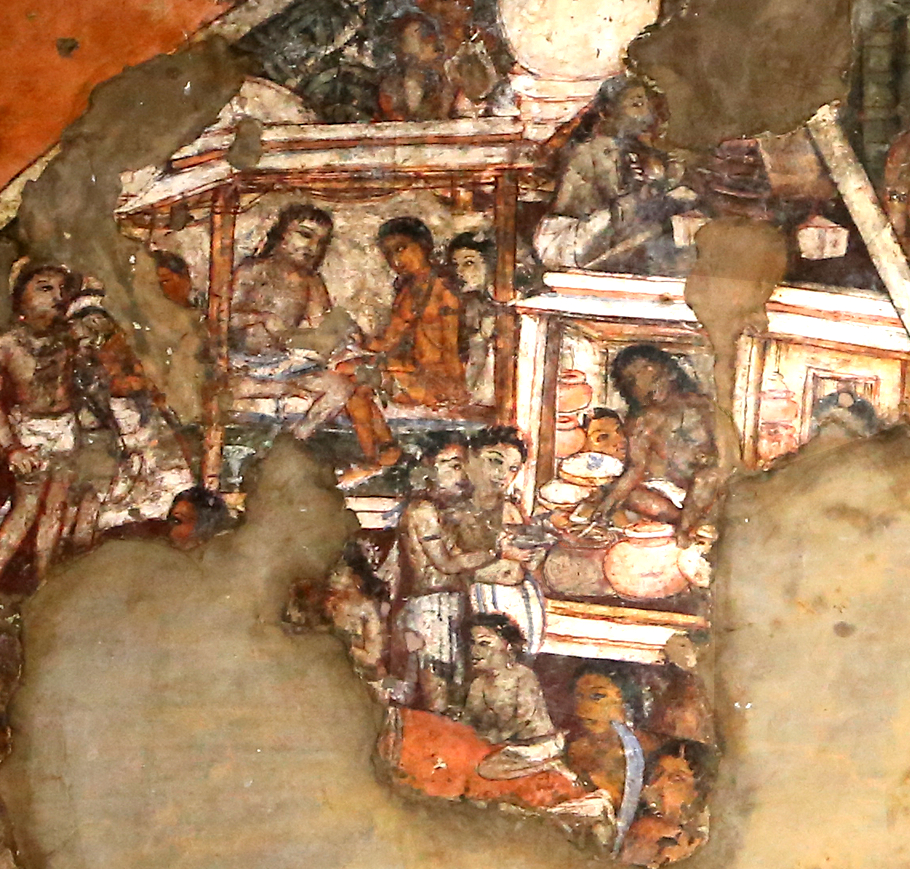 A surā shop: beer and other fermented drinks. Rare image, painting on the left wall of the vestibula in Ajanta Cave 17 (4th-6th century) (Whole wall).
A surā shop: beer and other fermented drinks. Rare image, painting on the left wall of the vestibula in Ajanta Cave 17 (4th-6th century) (Whole wall).
The development of specific methods to convert starch sources into fermented beverages, into beer namely, goes hand in hand with the emergence of specialised professions. The brewer is called surā-kāráṃ in a Vedic text (Vājasaneyi Saṃhitā 30.11: "87. Kīlālāya surākāráṃ")[15]. He works at home in a room that serves as a brewing workshop (surāpaṇa) and a place to sell. A flag (dhvajastambha) signals to drinkers (śauṇḍā) that beer is for sale. There are less specialised shops and taverns (pānāgāraṇi) for buying and drinking various kinds of fermented beverages, of which the Arthashastra details the regulations that fermented beverages sellers (śauṇḍika) must follow. The level of specialisation is low: he or she who knows how to brew beer (whatever the method) also knows how to make wine or mead, depending on the season. A wall painting from the 4th-6th century in cave 17 in Ajanta shows a surā shop[16].
Two twin features characterise this historical development in India as in other brewing regions in the world: 1) Brewing beer is identified as a real human task, both ingenious and strenuous. It is contrasted with the generous (and divine) spontaneity of palm, sugarcane or various fruit wines. 2) Surā-beer is considered by Brahmin scholars to be a composite drink, an assemblage of cooked food substances (grains, pulses, tubers), plants and an ingredient with mysterious powers, the kiṇva ferment. The strange mixture that gives rise to beer is again opposed to the simple (and pure) composition of wines when looked upon by the Brahmins. This dual conception (beer = human labour/intelligence, beer = mixture/amalgam) is echoed in the texts.
A worker-brewer (śauṇḍikākammakara) wants to "shake up" the Buddha's arguments: « as a strong brewery worker, placing a great brewer’s basket (śauṇḍikākilaṅjaṃ) into a deep pond of water and grasping the edges/corners, would drag it toward him and drag it this way and that … » ou bien « As a strong brewery rogue (śauṇḍikādhutta), grabbing the sieve (vālam) by the edges/corners, would shake it off, shake it out, and throw it about … » (Upāli Sutta, quoted after McHugh 2021, 81). The basket for soaking the grains and the sieve for filtering the fermented mash are described as large objects. This means several things:
- surā-beer making has moved beyond the domestic stage,
- specialized staff handle these tools,
- beer brewing has become a regular activity,
- brewing techniques will become more sophisticated or specialised.
At the dawn of the Indian Middle Ages, the Tantras divide fermented beverages into two classes: grape wine on the one hand, and compound and manufactured drinks on the other. « And it is two-fold : manufactured/fabricated (kṛtrimā) and simple (sahajā). The manufactured is threefold : made from grist, from honey, and from jaggery ; and there is ony one simple/natural one, produced from grapes … ». « Grist-based (paiṣțī), jaggery-based, and honey-based surā are said to be manufactured/fabricated. » (Abhinavagupta (975-1025). His Tantrāloka exerpt quoted/translated by McHugh 2021, 255). Paiṣțī refers to anything that comes from grains (grits, flour, etc.). The triplet of 'compound' drinks includes beer (paiṣțī surā), sugarcane wine (sīdhu) and mead (honey, madhu). It is confusing, according to our scientific nomenclature, to see mead described as a 'manufactured' drink, clustered with beer and opposed to totally natural grape wine. For diluted honey also ferments spontaneously. Most important is the nomenclature itself. It is based on practical experience and classification of fermented drinks dating back to the dawn of our era. The criteria for classification vary according to the texts: technological, practical, theological, etc. But they all reveal that beer is now clearly identified and isolated as a fermented drink made from ground grain (paiṣțī), i.e. starch according to a modern definition of beer.
c) Specialisation step II: the beer-ferment technique supersedes malting around 200 BC.
Another important development seems to have taken place at the outbreak of our era. The wide range of brewing techniques is narrowing. The amylolytic ferment technique became predominant, apparently at the expense of malting, i.e. the germination of cereal grains. This specialisation of beer brewing methods is already apparent in the political treatise Arthashastra.
This text mentions 3 types of beer. All of them are brewed with the kiṇva beer ferment, without any malt addition (Indian-Maurya Empire/Beer list and composition). Malting techniques are gradually abandoned in the Ganges and Indus valleys in favour of amylolytic ferments adapted to the dominant crop, rice. This would be an example of the specialisation of brewing methods that occurred in the Indian subcontinent following a slow evolution of cereal cultivation.
The extensive nomenclature of beer-ferments (beer-starter) testifies to their refinement and specialisation adapted to various kinds of beer. Kiṇva, bijabandha, surā-bijā, nagnahu (based on roasted barley or urd bean) are the most frequent terms, declined according to the origin of the starch that serves as a substrate for their making. The other essential ingredient of beer ferments are plants (stems or roots) carrying amylolytic fungi or amylolytic enzymes. They are called sandhāna-oṣadhi, lit. plants/plant organs (oṣadhi) [triggering] fermentation (sandhāna) (Rasahṛdaya iii.4, quoted by Mira Roy 1997, 442). Sandhāna means fermentation in a general sense (alcoholic, lactic, acetic, butyric fermentations). Its association with the plant world reduces the field of application to the fermentations of beer and wine, alongside other fermented food preparations (vinegars, sauces, fermented pulses, pickles, etc.).
Another technical term, sambhāra, refers to the combinations of aromatic plants or spices associated with the making of fermented beverages. When brewing beers, these plants may have also provided amylases.
The particular technical role of amylolytic ferments (kiṇva) offered a striking image to an Indian materialist philosophical school known as the Charvaka. It preceded the Naiyāyikas, Vedāntins, Jains and Buddhist schools in the 6th century BC. To explain that consciousness emerges from matter (physical body) without supernatural action, these philosophers borrow from the phenomena of fermentation known to all, and especially from the "mysterious" powers of beer ferments:
1.1 We shall now explain the principle.
1.2 Earth, water, fire and air are the principles, nothingelse.
1.3 Their combination is called the “body”, “sense” and “object”.
1.4 Consciousness (arises or is manifested) out of these.
1.5 As the power of intoxication from kiṇva [when surā-ingredients are mixed]. kiṇvādibhyo madaśaktivat
1.6 The self is the body endowed with consciousness.
1.7 From the body itself.
1.8 Because of the existence (of consciousness) where there is a body.
1.9 Souls are like water bubbles. (Bhattacharya 2011, 87)
By the dawn of our era, brewing technology in India was well established. It was used to brew various types of beer, but also various fermented foods made from grains or plants: marinades, fermented sauces, .... This widespread use of amylolytic ferments explains the gradual disappearance of malting in India. Other economic factors may have contributed to this decline: the cost of malting, for example, or the challenge of controlling the germination and therefore the malting of paddy rice, which has become the dominant cereal in northern India. It should be noted, however, that the malting of grains for brewing beer is still practised for a long time in the foothills of the Himalayas where barley, eleusine and millet dominate in areas inhabited by non-Hindu peoples.
For example, the kingdom of Bhutan attests to the existence of chang beer in the 8th century. There are no records before that date. The story of Padmasambhava, a powerful tantric master from present-day Pakistan, tells that in the 8th century a banished prince of Indian origin named Sindha Ra-tsa founded a kingdom in the region of Bumthang (eastern Bhutan), after being defeated by the Indian king sNa'u-che. Seriously ill, he called upon Padmasambhava. Healed, the king offers a cup of chang beer to Padmasambhava and grants him what he requests[17]. In the 8th century, chang beer was one of the fermented beverages at the court of a prince in a high valley in the Himalayas. But we do not know its composition and especially its brewing technique: malting, amylolytic ferment, amylolytic plant, insalivation, sour medium? (The Bhutanese Way to beer)
The ancient history of Nepal offers similar examples without being able to go back before the Gupta dynasty (400-600).
d) Specialisation step III: improvement of beer ferments at the turn of our era.
The refinement and specialisation of beer ferments is evidenced in the sophisticated brewing of beer for the pleasure of royal courts, in the fields of medicine (Ayurveda) and alchemy.
The Mānasollāsa (Delights of the Mind), composed in 1131, is an encyclopaedic work describing the organisation of the court of King Someśvara III (r. 1127 - 1138) ruling the vast Kalyani Chalukya kingdom in southwest India. It describes the brewing of beer, in this case two kinds of beer favoured by the court: pale-surā and black-surā. The technical data are more accurate than that given in Book II chap. 25 of the Arthashastra, although the proportions of ingredients are omitted.
These two brewing 'recipes' operate in 3 separate phases: 1) making the ferment, 2) mixing ferment + cooked grains in a closed vessel, heating = surā bijā 3) adding water to obtain the beer + filtration.
Pale Surā :
« Dry and grind to powder foxtail millet (priyaṅgu) that has been placed in water. Mix sorghum gruel (yavanālayavāgū) with that powder. [=> ferment à bière à base de millet et de sorgho, ou de sève sucrée du sorgho (yavanālayavāgū)]
Place more grist (piṣṭa) of the same sort in a jar (ghaṭe) abundantly. Having dried boiled rice (odana), mix it with that ground grain. [=> masse de riz cuit et de farine de riz (piṣṭa)]
Put the aforementioned gruel in that grist and boiled rice. [=> mélange riz cuit + ferment à bière]
Place that in jars and keep it in a sheltered place. Warmed for a day and a night and sprinkled, the grist has the odor of intoxicating drink (madyagandhi).
This is called lavaṃ and is an intoxicating surā-seed (surābija).
Add ten-fold of drinking water to that and filter it (gālayet), or surround it with cloth and filter the pure/clear liquid (nirmalaṃ rasa).
In this way, using rice (śāli), wheat (godhūma), barley (yava), millet (śyāmāka), or kodo millet (kodrava), one makes the grist-based surā called "pale" which is agreable and tasty. » (Mānasollāsa Book 5, chap. 10, v. 431bc-437ab, quoted after McHugh 2021, 40)
The recipe for pale-Surā : its pale colour comes from the (exclusive?) use of well-hulled and milled rice, probably a white variety, without the addition of colouring plants. Its short fermentation (1 day) and the filtration of the supernatant offer a very clarified beer. It should be noted that the ferment is only made of millet (raw?) and sorghum or its sweet sap. Its power to saccharify the rice mass is problematic. It must be assumed that the sorghum sap (yavanālayavāgū) is rich in amylases that can saccharify the starch of the cooked rice (odana), in which case the brewing of the pale surā would follow method No. 4. There may be a reminiscence of malting (method No. 2) in the soaking of the millet and its drying. This beer can also be brewed with wheat, barley, or various kinds of millet.
Black Surā :
« Thouroughly bruise clean bark (or rind) of majjanā, barley (yava), ghoṇṭtaka, rohiṇī, boil them, afterward dry them in the sun. Powder fermented grain gruel (kulmāṣakam) and mix it with that powder. [=> les écorces broyées et cuites de plantes ne servent pas de ferment, mais de colorants bruns et d’aromates. La pâte de grains fermentés (kulmāṣakam) d’un précédent brassin joue ce rôle]
Make grist from sorghum (yavanāla), mix it with all that. Mix it again in a bamboo tube and cover it for a long time, with heat (saṣmaṇā), for 3 nights or 5 nights until it turns black. [=> masse de sorgho (cuit ?) + ferment]
Then an expert should add water according to the quantities of surā-seed (surābija). Having stirred it, cover it and lay it down well concealed.
Thus one prepares black (kṛṣṇa)-surā which has odor, dark color, and flavor, which especially produces drunkenness, and which has bitter and sweet flavor. » (Mānasollāsa book 5, chap. 10, v. 437bc-442ab, quoted after McHugh 2021, 40)
The recipe for black Surā: the bark or stems of plants and barley straws are boiled and then dried, thus partially removing their tannins. They are the source of the final brown colour of the beer. The beer ferment reuses a fermented mass of grain, probably the sediment from a previous brew of black Surā.
These two recipes brew surā-beer with amylolytic ferments or sediments derived from their use, but do not clearly explain their very making. The use of ferments is deduced from the semi-solid phase of saccharification-fermentation in jars or bamboo tubes, before adding water to dilute the fermented mass and get the beer.
The late (12th century) commentaries on the Ājurveda written by Ḍalhaṇa give some clarification on the appearance of surā-beer after the addition of water, mixing and a period of rest in a beer jar. The clear supernatant is the prasannā. Jagala refers to the semi-liquid part that can be rediluted for drinking. Bakkasa refers to the lees consisting of herbs (residues of beer-ferment kiṇva), yeast (residues of fermentation) and dregs (grain residues). The dried bakkasa can be reused as ferment for a new brew and is often confused with the kiṇva-ferment itself.
« Surā [Surā has a red, lohita-, color, is a little cloudy with grist, ferment and sediment].
Svetā surā [White surā is made from roots of white punarnava and others herbs, grist of paddy and ferment. Well known as katolī].
Prasannā [Prasannā is the supernatrant layer of surā, the uppermost clear part].
Yava surā [This is surā made from barley and ferment].
Kohala [Kohala is made from cooked barley flour, saktu, kauhalikā in the common language. Others, however, say it is surā made from cooked rice, which is what the Pauṇḍra people (Bengali) call kāncanāli].
Jajala [Jagala is the lower sediment of intoxicating drink that is discharged separately. According to others, surā made from kiṇva and cooked rice is jagala].
Bakkasa, dregs [Bakkasa is just non-liquid jagala, merely kiṇva and herbs]. » (quoted after McHugh 2021, 38)
A later text (13th-14th century), the Sharṅgadhara Compendium (Śarṅgadharasaṃhitā), describes this more succinctly and clearly. This time we have 4 densities or layers composing the surā-beer in its jar:
« That which is made from the fermentation of well-cooked rice is called surā. The supernatrant part is clear [=> prasannā]. Kādambarī is denser than that, and under that it is called jagala, and medaka is denser than jagala. With the essence (-sāra) removed, it is vakkasa [=> bakkasa, dregs]. And surā-seed (surābījam) is kiṇvaka. » (quoted after McHugh 2021, 38-39)
* * * * *
The beer-ferment technique and its characteristic semi-solid-phase of saccharification-fermentation determine the way in which the beer is brewed and the ingredients used, potentially all sources of starch (cereals, tubers, legumes). They also dictate the way the beer is served and drunk. In the same jar, these 2 or 3 layers of more or less clarified or dense beer match more or less appreciated qualities. The supernatant is the most valued portion, the clear surā or prasannā. Next comes the kādambarī, etc. This vertical typology of the beer jar perhaps has its social translation: a more or less clarified quality of beer for each social category.
The beer-ferment technology induces another important consequence. Surā-beer is itself neither strong nor weak. Its alcohol density depends on the volume of water added to dilute the surābijā a short time before drinking it. Several successive dilutions of the fermented mash (surābijā) can be made to obtain a gradually weaker beer. To call surā-beer a strong drink is meaningless. The guests gathered around the beer jar decide at the last moment on its 'strength'. This implies a social etiquette and drinking manners that are different from those found in Western societies in the past and today[18].
* * * * *
Another example of the eminently technical role of beer ferments comes from Rasaśāstra, the science of cures based on plants, materials of animal origin or minerals. Rasa also refers to mercury. Rasaśāstra is a part of Ayurveda, the traditional Indian science of human life, the medicine. Rasaśāstra had its heyday around the 8th century. Many healing preparations use recipes of beer ferments, the kiṇvas. Beer has many uses in traditional medicine.
The alcohol in beer is used as a solvent for potions. The technique of amylolytic ferments makes it possible to push the alcoholic fermentation towards higher densities (15-20% alc.). The boundary between fermented and distilled beverages becomes somewhat blurred. This explains why this technique was improved and specialised by physicians and alchemists.
One such recipe is laid down in the Rasopanisat (RP. XV 251-253) written in the 12-13th. It aims to purify metals, amalgamate them or dissolve some of their compounds to make powerful medical potions. Acidic plants play an important role next to the alcohol generated by kiṇva-ferment and surā-beer. Here is one of the recipes for beer-ferment to obtain an acidic medium :
« Among all the medicinal plants used as herbal drugs, the five tree-plants with latex known as best are vața (Ficus bengalensis L.), udumbara (Indian fig tree Ficus racemosa), aśvattha (bodhi tree Ficus religiosa), pārīṣa (portia tree Thespesia populnea) and plakṣa (white fig Ficus lacor). These in equal are pounded. To this powder (cūrṇa) a mixture of rice (taṇḍula), kodo millet (kodrava, Paspalum scrobiculatum), madanaphala (emetic nut Randia dumetorum), is ground and pasted with whey of buffalo or cow-milk (mahiṣi dadhi mastu). This is then pasted over leaves of copper (arkapatra) and placed in a bronze vessel.
The drugs known as sour-plants (amlavarga = lime, orange, pomegranate, tamarind, wood-apple, sorrel, Lakucha, Spondias and others) and aromatics (sugandhita) are used to prepare a fermented mash (surābīja) which is known as a beer ferment (kiṇva), the residue of surā-beer.
The same beer-ferment (kiṇva) ingredients and the powder of the five lactiferous plants [see above], pūtiloha [a group of 4 metal : copper, iron, lead, tin], sankara [another group of metals : brass, …], uparasa [group of 7 minerals, orpiment, sulphur, alum, hematite, …], paricalavaṇa [5 kinds of salts] along with țaṅkaṇa [borax], are procured, mixed and ground for preparing a paste (lepa).
This paste should be applied as a coat (pralepa) in a bronze pot. Then, a bowl (sampuța) of arkapatra [copper leaves coated with herbal-rice paste, see above] is placed on a pot filled with surā [brewed as above]. It is processed under the method of fermented beverages (āsava vidhi/madira sandhana). The fermentation process (Āsava vidhi), in general, is commonly prescribed for preparing fermented beverages (āsavana vidhāna). » (Gyanendra Pandey 2011, 230-231).
The Rasopanisat contains many receipes like this one preparing and using kinva-beer-ferments to purify or dilute metals in order to make medical potions, pills or ointments. These beer-ferments are used to produce an alcoholic or acidic medium in a technical development that is quite remote from food and beer brewing techniques.
4. Conclusions :
The Indian subcontinent is a global brewing hotbed, the magnitude of which is, to date, totally unknown.
India is not only a bridge between East and West in historical times. India's protohistory is very specific. Plants from Western and Eastern Asia, from Africa and Central Asia have been cultivated and mixed with indigenous plants since the 7th millennium (map). This crossroads of starchy plants has unsurprisingly become a hub of brewing traditions where several competing or complementary brewing techniques have coexisted.
The proposed historical framework remains sketchy and very provisional due to the lack of extensive studies on the Indian protohistory of fermented beverages. It leaves many grey areas regarding the development of brewing in southern India and among the non-Hindu majority populations of ancient India. Analyses of fossil residues of fermented beverages could fill in these gaps and provide a more accurate, scientifically verifiable chronological scheme.
Developments linked to influences from the East (Tibetan-Burmese populations), China, or the West (Persia, Kushan Empire, etc.) are still hard to discern and undoubtedly underestimated.
The recent identification of a probable millet-based fermented beverage brewed in the city of Gonur Depe (2400-1600 BC) and in the fortress-temple of Togolok 21 (2000-1500 BC) located in Margiana constitutes a very interesting material clue associated with the Bactria–Margiana Archaeological Complex (BMAC)[19]. Negative imprints of grains found inside jars used in a ritual context were first published as those of hemp seeds (Cannabis sativa) or Ephedra[20]. These imprints turn out to have been left by millet grains (Panicum miliaceum) (Bakels 2003). If fossil chemical compounds characterising alcoholic fermentation are found in these ceramics, the ritual beverage of Gonur Depe and Togolok 21 would in fact be a millet beer!
It is hoped that archaeological and historical research will explore this field left untouched by classical Indian studies. The technical and social interactions between starchy food plants and fermented beverages are generally a fertile ground of investigation. All the ingredients for a brilliant brewing history are present in ancient India: a rich array of starchy plants, advanced food technologies, a complex socio-economy, and a pervasive religion. On the scale of the Indian subcontinent with its multi-millennial history, the harvest can only be fruitful.
Bibliography :
- Achaya K. T. (2015), Technology of Food, in Bag A. K., History Of Technology in India, Vol. I, 448-476. archive.org/details/in.ernet.dli.2015.205662
- Allchin F. R. (1979), India. The Ancient Home of Distillation. MAN NS 14-1. jstor.org/stable/2801640
- Allchin F. R. (1963), Neolithic Cattle-Keepers of South India: A Study of the Deccan Ashmounds. Cambridge University Press.
- Agnihotri Rajesh, Anjum Farooqui, Nitesh Khonde, Runcie Mathews (2021), "Microscopic, biochemical and stable isotopic investigation of seven multi-nutritional food-balls from Indus archaeological site, Rajasthan (India). Journal of Archaeological Science: Reports 37(3).
- Aris Michael (1979), Bhutan: The Early History of a Himalayan Kingdom, Ed. Aris & Phillips Ltd.
- Bakels C. C. (2003), The contents of ceramic vessels in the Bactria-Margiana Archaeological Complex, Turkmenistan, Electronic Journal of Vedic Studies Vol. 9:49-52. hasp.ub.uni-heidelberg.de/journals/ejvs/article/view/785
- Bhattacharya Ramkrishna (2011), Studies on the Carvaka/Lokayata. archive.org/details/StudiesOnCarvakaLokayataRamakrishnaBhattacharya
- Boivin Nicole, Fuller Dorian, Korisettar Ravi, Petraglia Michael (2008), First Farmers in South India. The Role of Internal Processes and External Influences in the Emergence and Transformation of South India's Earliest Settled Societies. researchgate.net/publication/234128675_First_Farmers_in_South_India_The_Role_of_Internal...
- Bourgeois G., Gouin P (1995), Résultats d’une analyse de traces organiques fossiles dans une « faisselle » harappéenne, Paleorient persee.fr/doc/paleo_0153-9345_1995_num_21_1_4613.
- Damerow Peter, Englund Robert (1989), The Proto-Elamite Texts from Tepe Yahya. American School of Prehistoric Research, Peabody Museum. Harvard University Bulletin 39. cdli.ucla.edu/staff/englund/publications/englund1989b.pdf
- Dumont Paul-Emile (1963), The Human Sacrifice in the Taittirīya-Brāhmaṇa: The Fourth Prapāṭhaka of the Third Kāṇḍa of the Taittirīya-Brāhmaṇa with Translation, Proceedings of the American Philosophical Society Vol. 107, No. 2. jstor.org/stable/985448
- Fuller Dorian (2005), Ceramics, seeds and culinary change in prehistoric India, Antiquity 79(306):761-777. researchgate.net/publication/279539931_Ceramics_seeds_and_culinary_change_in_prehistoric_India
- Fuller Dorian, Korisettar Ravi, Venkatasubbiaah P. C., Jones Martin (2004), Early plant domestications in southern India. Some preliminary archaeobotanical results, Vegetation History and Archaeobotany (2004) 13:115–129. researchgate.net/publication/225538516_Early_plant_domestications...
- Fuller Dorian (2003), An Agricultural Perpective on Dravidian Historical Linguistics. Archaeological Crop Packages, Livestock and Dravidian Crop Vocabulary, in Bellwood & Renfrew, Examining the farming/language dispersal hypothesis. McDonald Institute Monographs, pp. 191-213.researchgate.net/publication/32894252_An_agricultural_perspective_on_Dravidian_historical...
- Fuller Dorian, Madella Marcos (2001), Issues in Harappan Archaeobotany: Retrospect and Prospect. In Indian Archaeology in Retrospect, Volume II. Protohistory:317-390. researchgate.net/publication/234154064_Issues_in_Harappan_Archaeobotany...
- Gyanendra Pandey (2011), Rasopaniṣat [Rasopaniṣad]. (Sanskrit text with English Commentary-Comprising suplements/annexures/appendices). Krishnadas Ayurveda Series 137.
- Horner I. B. (1957), The Book of the discipline (Vinaya-pitaka) (Pali), Vol. 2, London, Published For The Pali Text Society, p. 385. archive.org/details/bookofthedisciplinevinayapitakavol2suttavibhangahorneri...
- Kolhatkar Madhavi Bhasker (1999), Surā: The Liquor and the Vedic Sacrifice.
- Mathpal Yashodhar (1984), Prehistoric Rock Paintings of Bhimbetka, Central India. Abhinav Publications.
- Marshall John Robert (1951), Taxila: an Illustrated Account of Archaeological Excavations Carried out at Taxila under the Orders of the Government of India between the Years 1913 and 1934. Cambridge University Press.
- McHugh James (2021), The Ancient Indian Alcoholic Drink Called Surā: Vedic Evidence, JAOS 141, pp. 49-72. doi.org/10.7817/jameroriesoci.141.1.0049
- McHugh James (2021), An Unholy Brew. Alcohol in Indian History and Religions, Oxford University Press.
- McHugh James (2020), Too big to Fail: The Idea of ancient Indian Distillation, in D. N. Jha, Drink of Immortality. Essays on Distillation and Alcohol Use in Ancient India, Manohar, 41-61.
- Mira Roy (1997), Fermentation Technology, in Bag A. K. History Of Technology in India. Vol. I, 437-447. archive.org/details/in.ernet.dli.2015.205662
- Mitra Rajendralal (1873), Spirituous drinks in ancient India, J. Asiatic Society of Bengal 42(1). archive.org/details/journalofasiatic4218asia/page/n3/mode/2up
- Olivieri Lucas (2008), Hanging Rocks and ‘Intoxicating Drinks’. The Rock Art Sequence of the Swat Valley. South Asian Studies 24:1, 15-26. tandfonline.com/doi/abs/10.1080/02666030.2008.9628678
- Oort Marianne S. (2002), Surā in the Paippalāda Samhitā of the Atharvaveda. Journal of the American Oriental Society, Vol. 122. jstor.org/stable/3087630
- Piperno Marcello, Tosi Maurizio (1975), The Graveyard of Shahr-i-Sokhta, Sistan Iran. Archaeology 28:3. academia.edu/2163442/The_Shahr_I_Sokhta_graveyard_Sistan_Iran_excavation_campaigns_1972_1978
- Prakash Om (1961), Food and Drinks in Ancient India. (From Earliest Times to c. 1200 A.D.), Munshi Ram Manohar Lal. archive.org/details/dli.ernet.103355
- Sarianidi Viktor (2003), Margiana And Soma-Haoma, Electronic Journal of Vedic Studies Vol. 9 :53-72. crossasia-journals.ub.uni-heidelberg.de/index.php/ejvs/issue/view/105
- Salvatori Sandro, Tosi Maurizio (2005), Shahr-i-Sokhta Revised Sequence . researchgate.net/publication/284328097_Shahr-e_Sokhta_revised_sequence
- Sarianidi Viktor Ivanovič (1986), Le complexe cultuel de Togolok 21 en Margiane. In: Arts asiatiques, tome 41, 1986. pp. 5-21. persee.fr/doc/arasi_0004-3958_1986_num_41_1_1195
- Silva & al. (2017), A genetic chronology for the Indian Subcontinent points to heavily sex-biased dispersals, BMC Evolutionary Biology 17. bmcecolevol.biomedcentral.com/articles/10.1186/s12862-017-0936-9
- Stevens & al. (2016), Between China and South Asia. A Middle Asian corridor of crop dispersal and agricultural innovation in the Bronze Age, The Holocene Vol. 26(10) 1541-1555. ncbi.nlm.nih.gov/pmc/articles/PMC5125436/
- Suryanarayan & al. (2021), Lipid residues in pottery from the Indus Civilisation in northwest India, J. of Archaeological Science. ncbi.nlm.nih.gov/pmc/articles/PMC7829615/
NOTES
[1] These groups of fermented beverages refer to social uses and techniques actually implemented by protohistoric Indian cultures. These categories of fermented beverages are not derived from a modern technological classification artificially plastered on ancient realities. Protohistoric Indian societies were aware of the technical differences between beer, wine, mead and fermented milk. The vocabulary of the Vedic texts naming these various fermented beverages around 1000 BC reveals a rich terminology and a lexical individuation based on both technical criteria and specific social uses.
[2] Electron microscopy of starch granules, phytoliths, plant remains and chromatography could provide essential data on the composition and technical evolution of protohistoric fermented beverages in India.
[3] Including the famous I.P.A. (India Pale Ale) brewed in the United Kingdom and transported in the holds of the East India Company ships. Before the Dutch, English and French, the Portuguese had been trading on the Indian coast since 1500. They introduced the cultivation of maize, which enriched Indian brewing methods without changing them in depth. The amylolitic ferment technique made it possible to brew any source of starch. In India, brewers did not need to reinvent corn malting to brew traditional beers from maize.
[4] Kolhatkar 1999. Oort 2002. McHugh 2021. Beer-studies en 2014-2016 (Vedic-brahmanic-India/Sura-beer-barley-rice - Surā brewing process - Indian-Maurya empire and Beer inventory. For decades, archaeologists, ethnologists and historians have adopted the correct generic term "beer" to describe archaic starch-based fermented beverages in Europe, Africa, Asia and America. Only Indian scholars are reluctant, still speaking vaguely of alcohol (liquor) and harbouring deep misunderstandings about distillation. Brahmanic traditions weigh heavily.
[5] Linguistics shows the existence of large 'blocks' forming an ancient substratum: Dravidian, Tibeto-Burman, Austro-Asian, Indo-Aryan languages. Recent genetic studies confirm that populations from Central and Western Asia migrated in waves to the Indian subcontinent between c. 10,000 and 2,000 BCE (Silva & al. 2017).
[6] But the interpretation of the archaeological data raises a serious methodological problem. The so-called "stills" are in fact a creation from disparate pieces of pottery belonging to different chronological strata or locations of archaeological sites such as Taxila in the Punjab (Marshall, 1951) or Shaikhan Dheri, Charsada (Allchin 1979).
[7] More efficient saccharification and fermentation to increase the alcohol content of drinks. Beer ferments are responsible for starch saccharification (amylases) and alcoholic fermentation. An efficient ferment should convert as much starch as possible into alcohol. This technical stage is a prerequisite for distillation to be economically sustainable. However, it seems that primitive distillations started with fruit, palm and sugarcane wines, maybe during the Kushan period (1st-3rd century AD) in Northern India.
[8] Arguments for the differentiation of fermented beverages as early as the 4th millennium. At the same site of Godin Tepe, wine and beer are contained in different jars. At Firaz, McGovern detected traces of wine around 5000 BC. The economic equation grains ⇔ beer is posed in the management of rations in kind in Mesopotamia and at Tepe Yahya (see Mesopotamian brewing-ratios).
[9] The only biochemical analyses concern lipids. Bourgeois, Gouin (1995) and Suryanarayan & al. (2021).
[10] See the very edifying article by McHugh (2020). As early as 1873, Mitra Rajendralal wrote a history of alcohol in India from the exclusive perspective of distillation. 150 years later, the approach of researchers has changed little!
[11] If the mastery of amylolytic ferments were confirmed for the protohistory of India, the form and function of vessels for brewing and serving beer might prove more complex. The use of beer ferments does not require a liquid phase during the actual brewing process, unlike the malting technique.
[12] Nowadays named Ādivāsīs and accounting for almost 9% of the Indian population, or 100 million people. This proportion was much higher 2500 years ago. They now live in refuge areas: Odisha, Bihar, Jharkhand, Chhattisgarh, Tripura, Assam and in the North East (Mizoram, Nagaland, Arunachal Pradesh).
[13] Contra Allchin F. R. (1979). In Buddhist texts translated by Chinese scholars (the Vinaya pitaka for example), surā = 穀酒 (gū jiu), 'grains-fermented beverage' = 'beer' in Western technical usage. The "5 grains" (wū gū) are millet, barley, rice, sesame and soybeans, or variants of other starchy grains.
[14] In Buddhist texts, the two varieties of rice Vrīhi (common rice) and Sāli (fine rice) are popular. However, Sāli rice and its four varieties Raktasāli (red rice), Kalamashāli (grown in Magadha), Mahāsāli and Gandhashali (fragrant rice) are the favourite food of the wealthiest.
[15] « 87. Kīlālāya surākāráṃ » « 87. To the drink-kīlālā the brewer of surā (is sacrificed) » (Dumont Paul-Emile 1963, 180). It is a ritual in which one sacrifices (actually or symbolically) to each affect of the world (anger, joy, unhappiness, love, ...) the person whose occupation is the best allegory in the eyes of the Brahmans. The drink-kīlālā is made of cooked rice (anna) (Vājasaneyi Saṃhitā III 43) and sweet (sugary?) (Atharvaveda Śaunaka VI.69.1) like surā-beer.
[16] The Ajanta site (Maharashtra State) consists of 30 Buddhist caves carved into a cliff, with murals celebrating the lives of the Buddha and the conversion of political potent individuals. Most of the murals are badly damaged. The vestibula of cave 17 depicts the human attachments (sex, violence, gambling, food, alcoholic drinks, etc) that form the cycle of rebirths (samsāracakra). The public sale of surā symbolises one of these attachments (3D visit of cave 17)
[17] Aris (1979, 46-47). The Padmasambhava's request to the king will be of course to sponsor the adoption and protection of Buddhism in his kingdom. Aris translates chang as "grape-wine". It should read chang-beer as noted by K. Phuntsho.
[18] The alcohol density of western beers brewed with the malting technique is instead determined by the grain/water ratio during the liquid phase of wort boiling.
[19] Sarianidi Viktor 1986 and 2003.
[20] Ephedra and hemp are two candidate plants to explain the preparation of Indo-Iranian Haoma or Indo-Aryan Soma, conjectures based on the few clues left by the Avestic and Vedic texts (colours, appearances, places of origin, effects on human behavior).



_throughout_Eurasia_between_5500–500 BC_(Stevens & al. 2016 fig. 3).jpg)
_throughout_Eurasia_between_5500–500 BC_(Stevens & al. 2016 fig. 4).jpg)
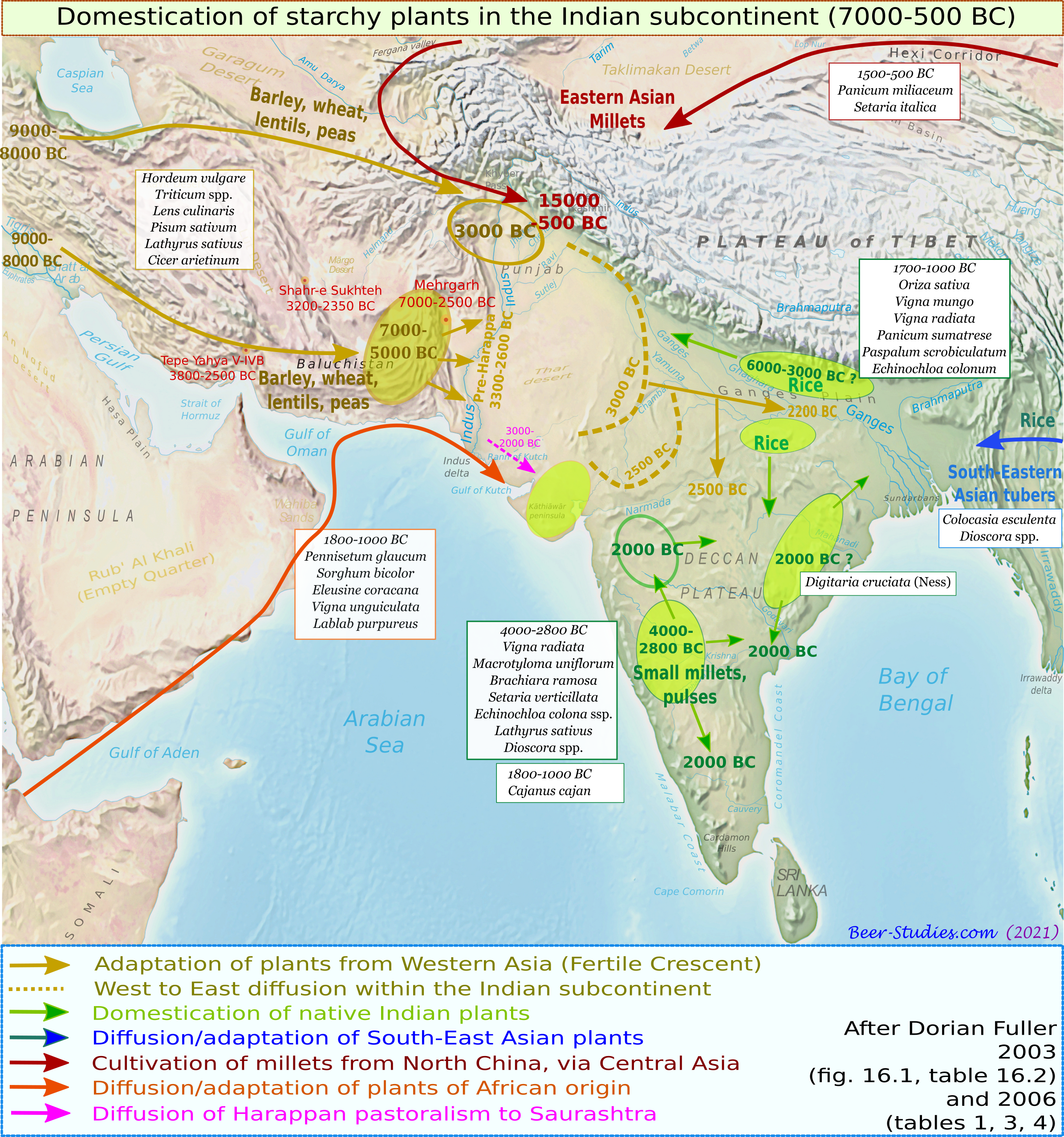
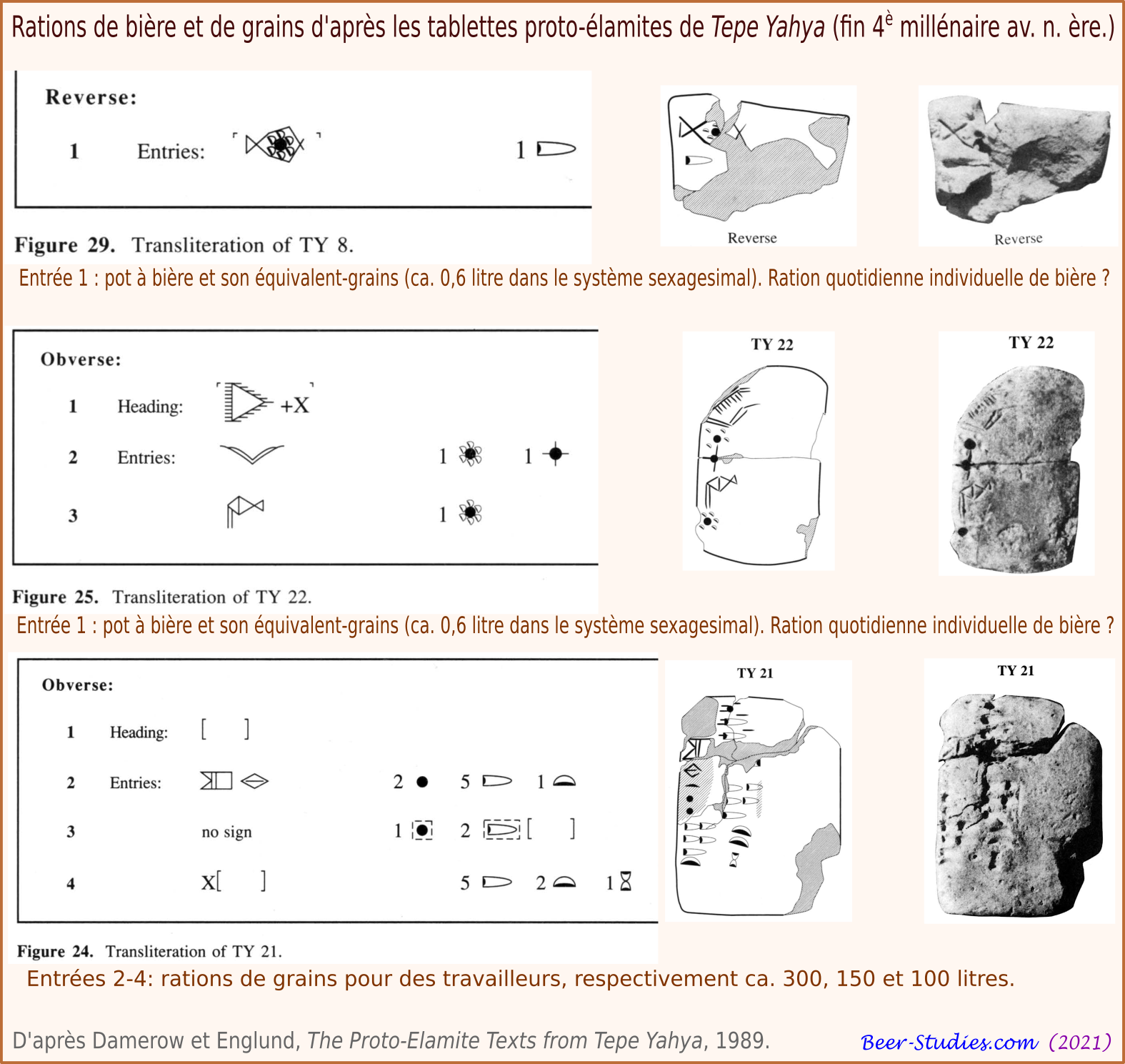
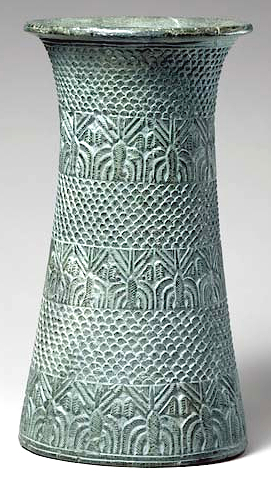
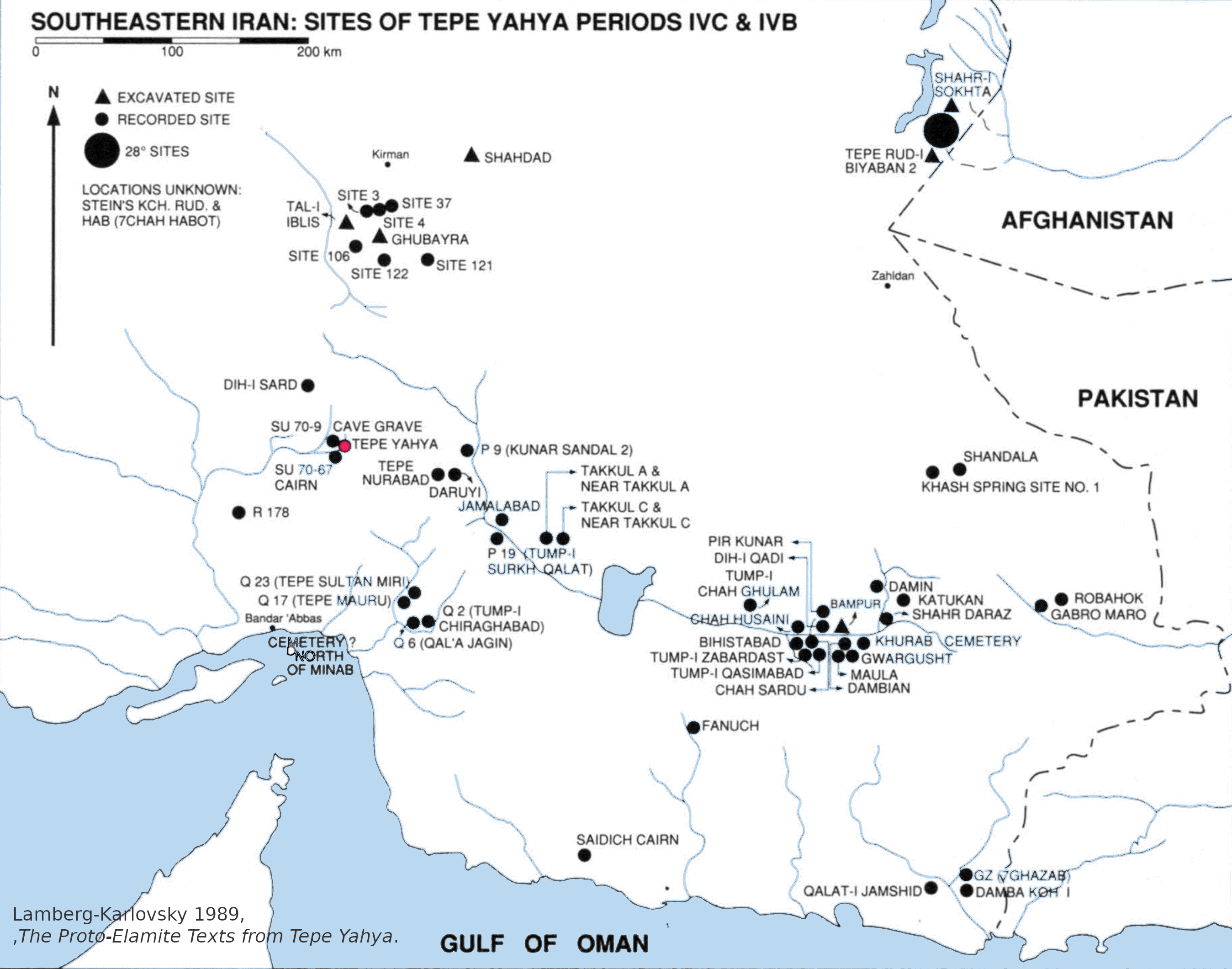
.jpg)
.jpg)
.jpg)
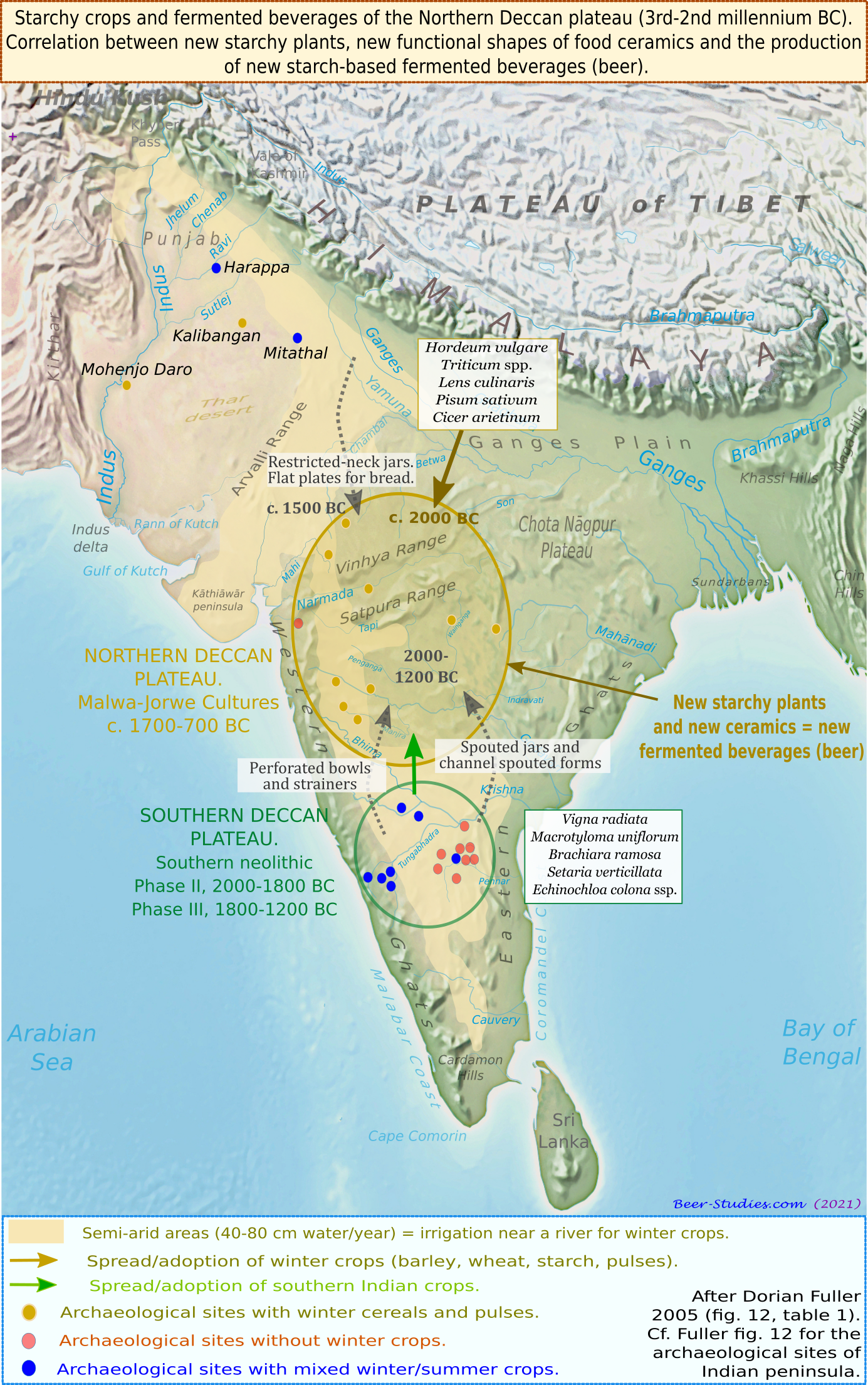
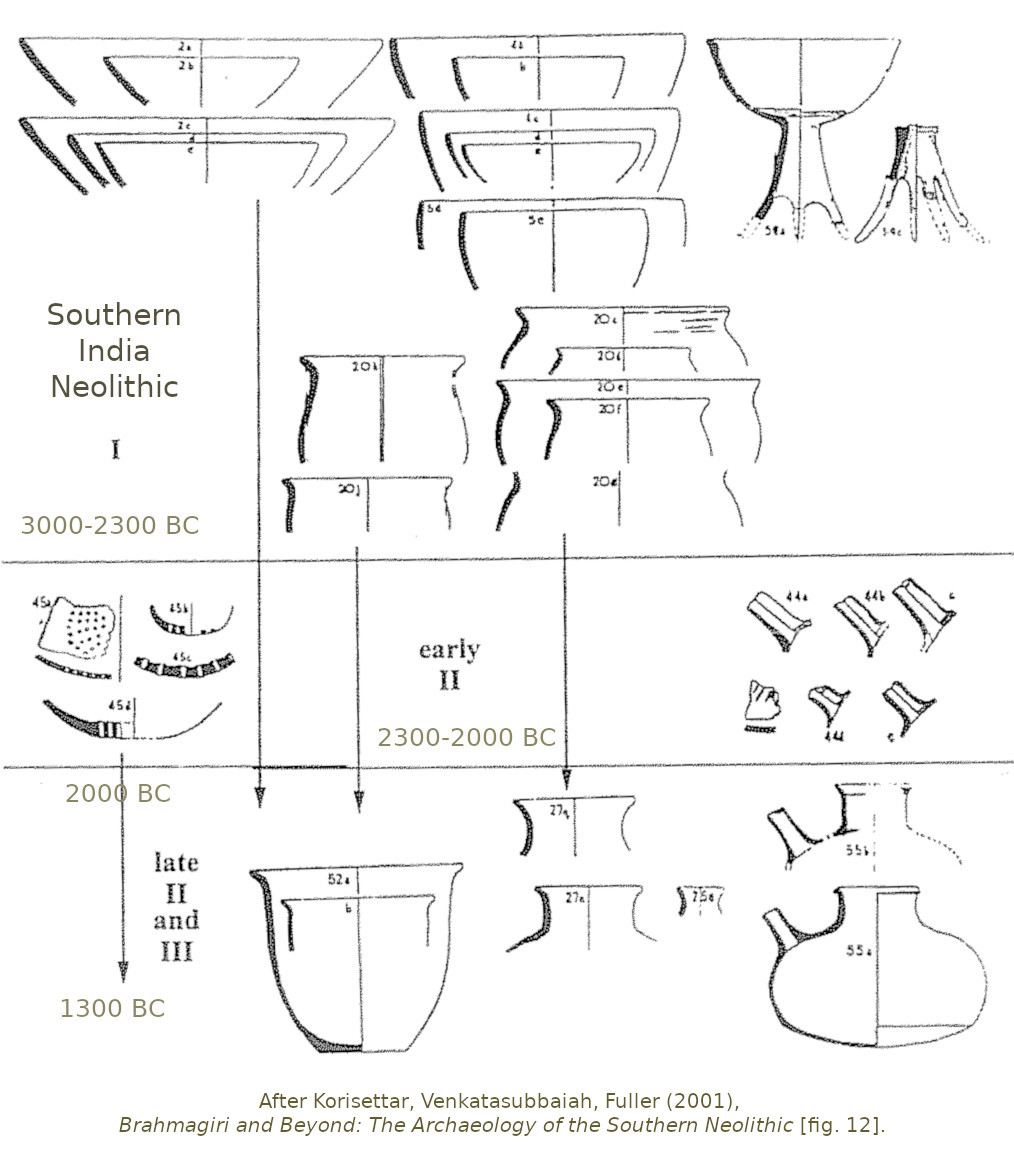
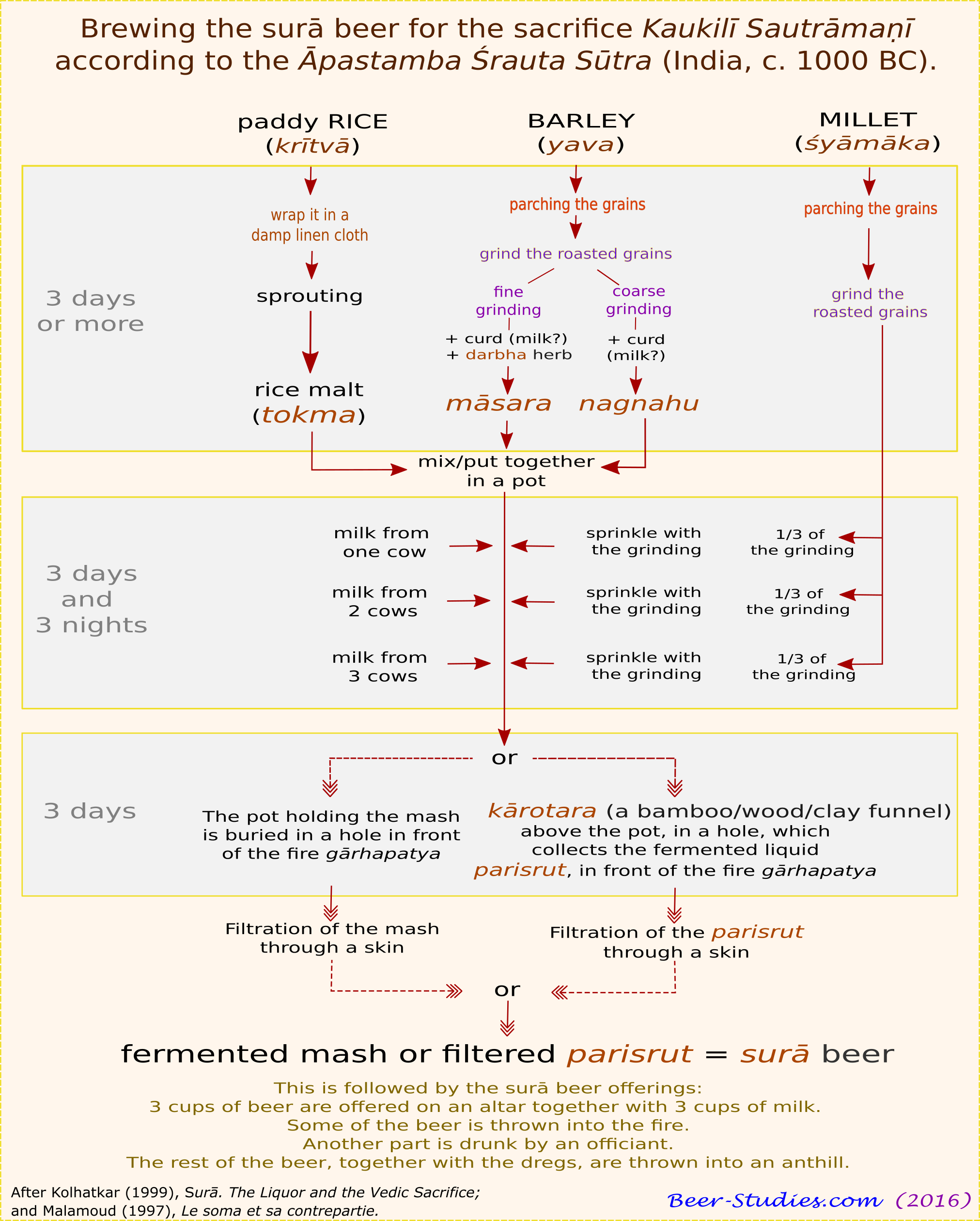
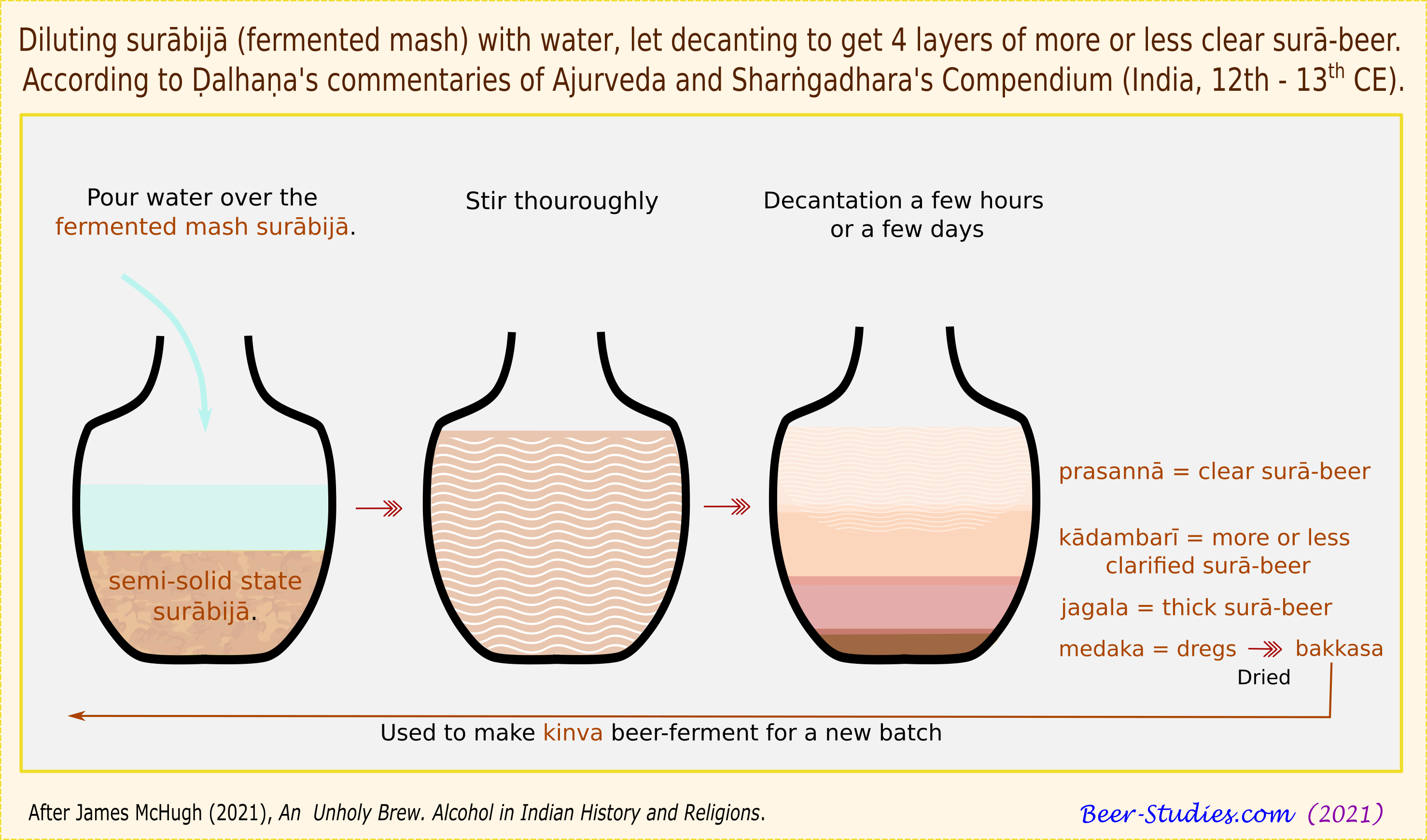
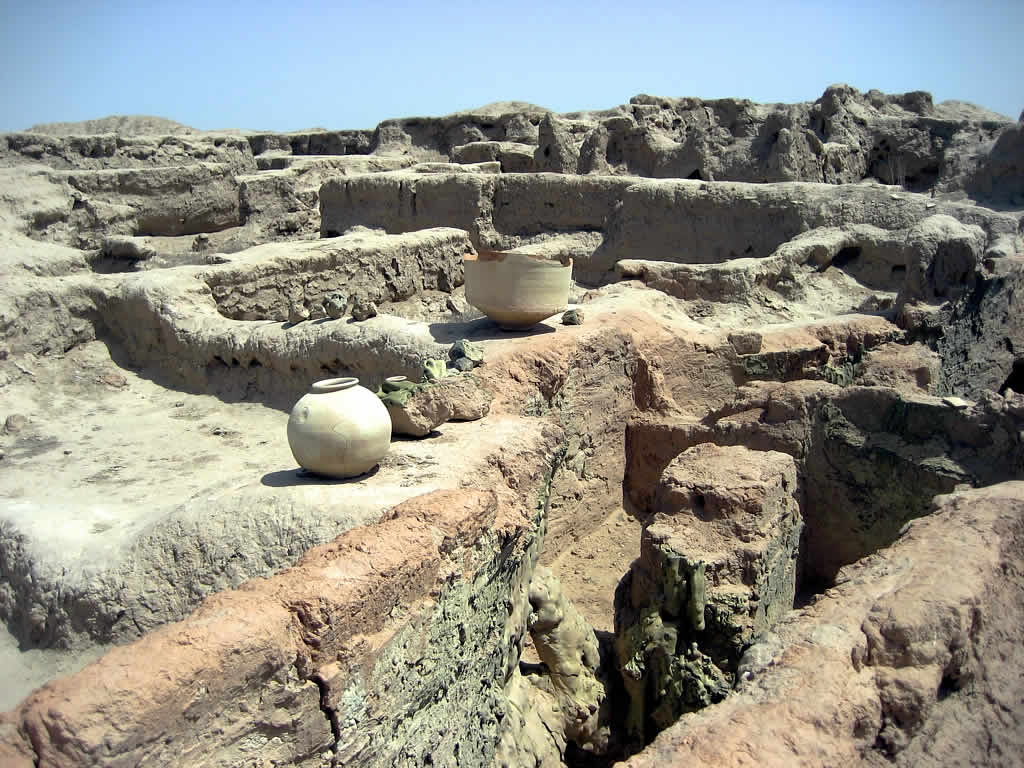
-EJVS_2003.jpg)
-EJVS-2003.jpg)